Complete Solutions to Linked Comprehension of chapter NEWTON'S LAWS OF MOTION 2 of Class 11 book with complete answers and questions
| Class 11 | PHYSICS |
| Chapter | NEWTON'S LAWS OF MOTION 2 |
| CENGAGE PHYSICS | Linked Comprehension |
| Number Of Questions | 52 |
| Academic Year | 2023-24 |
A monkey of mass `m` clings a rope to a slung over a fixed pulley .The opposite end of the rope is tried to a weight of mass `M` tying on a horizontal table is `mu` Find the acceleration of weight and the tension of the rope for two cases .The monkey move downward with respect to the rope with an acceleration b.
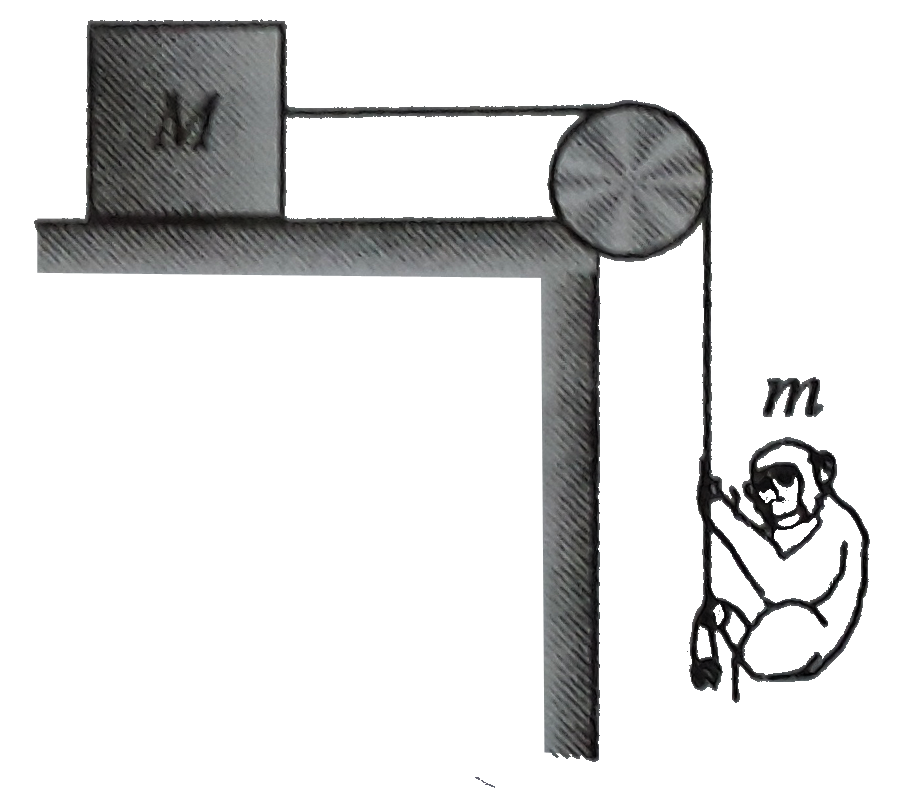
The acceleration of weight is
View SolutionA monkey of mass `m` clings a rope to a slung over a fixed pulley .The opposite end of the rope is tried to a weight of mass `M` tying on a horizontal table is `mu` Find the acceleration of weight and the tension of the rope for two cases .The monkey move downward with respect to the rope with an acceleration b.
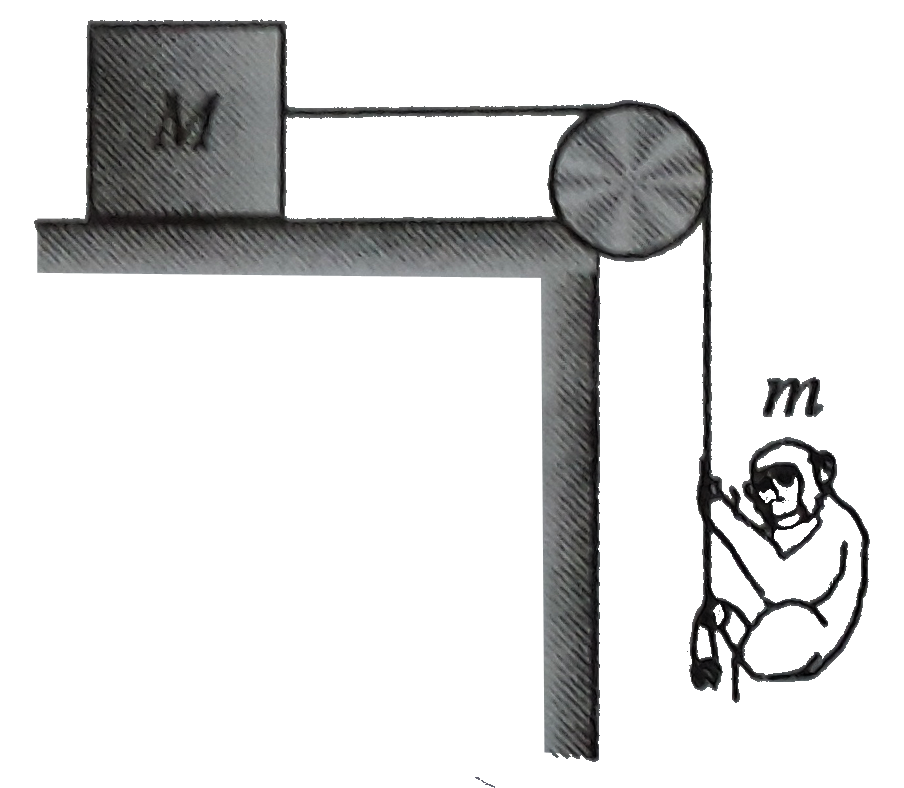
The tension of rope is
View SolutionBlock A weighs `4 N` and block weigh `8 N` The coefficient of kinetic friction is `0.25` for all surface find the force `F` to slide `B` at a constant speed when (a)`A` rest on `B` and moves with it (b) `A` is held at rest and (c )`A and B` are connected by a light cord passing over a smooth putting as shown in fig 7.31 (a - c) restively.
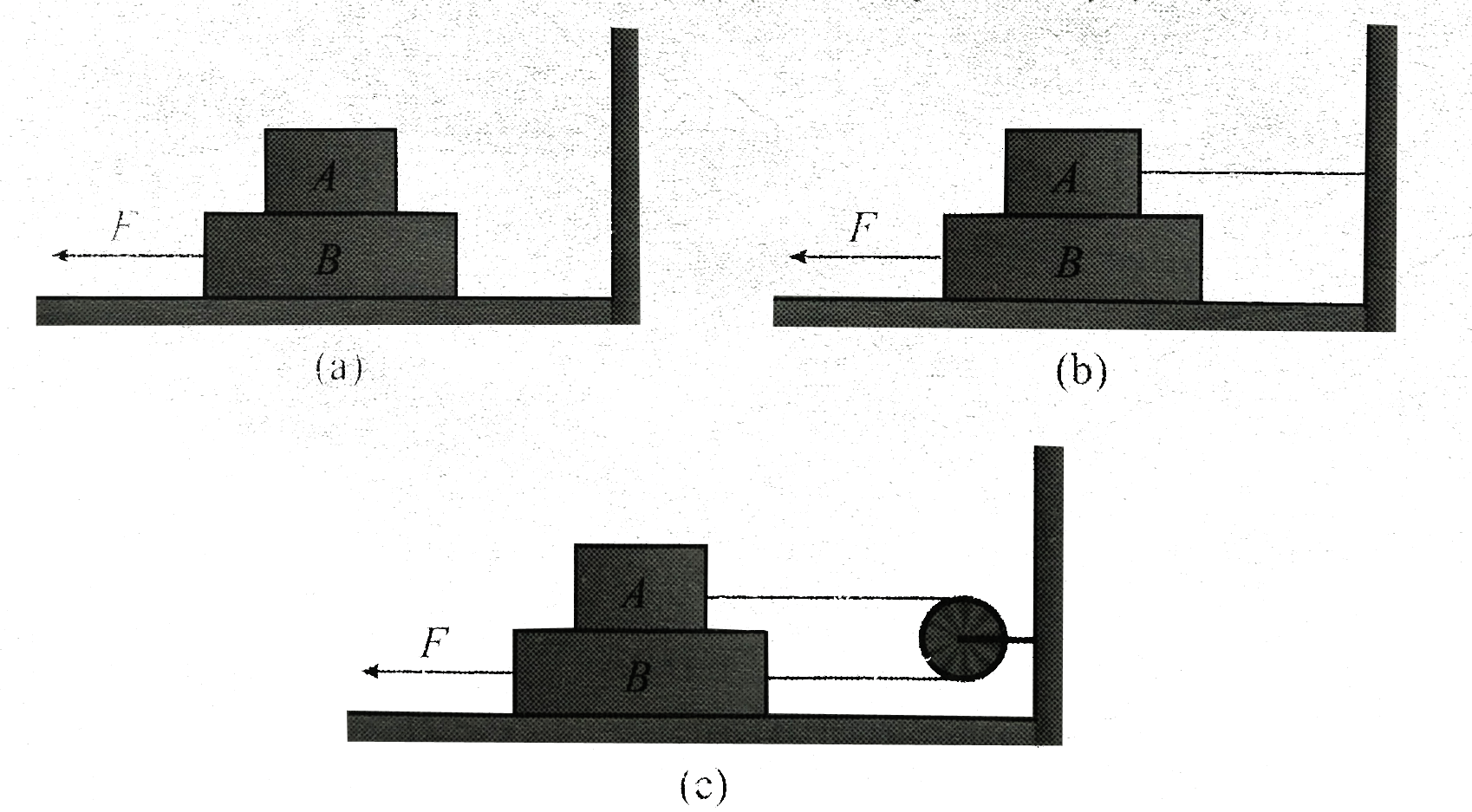
View SolutionBlock A weighs `4 N` and block weigh `8 N` The coefficient of kinetic friction is `0.25` for all surface find the force `F` to slide `B` at a constant speed when (a)`A` rest on `B` and moves with it (b) `A` is held at rest and (c )`A and B` are connected by a light cord passing over a smooth putting as shown in fig 7.31 (a - c) restively.

View SolutionBlock A weighs `4 N` and block weigh `8 N` The coefficient of kinetic friction is `0.25` for all surface find the force `F` to slide `B` at a constant speed when (a)`A` rest on `B` and moves with it (b) `A` is held at rest and (c )`A and B` are connected by a light cord passing over a smooth putting as shown in fig 7.31 (a - c) restively.

View SolutionBlock A of mass m and block B of mass `2m` are placed on a fixed traingular wedge by means of a massless inextensible string and a frictionless pulley as shown in figure The wedge is inclined at `45^(@)`to the horizontal on both sides .The coefficient of friction between blocks A and the wedge is `2//3` and that between block B and is released from rest find the following
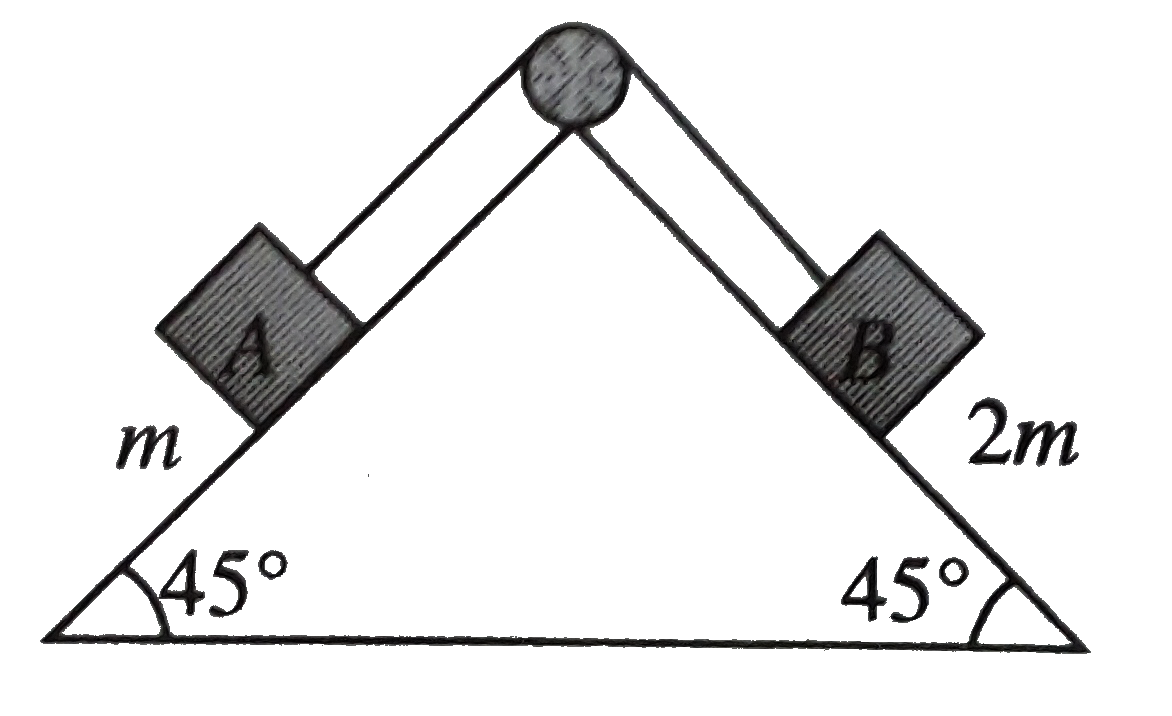
The acceleration of A is
View SolutionBlock A of mass m and block B of mass `2m` are placed on a fixed traingular wedge by means of a massless inextensible string and a frictionless pulley as shown in figure The wedge is inclined at `45^(@)`to the horizontal on both sides .The coefficient of friction between blocks A and the wedge is `2//3` and that between block B and is released from rest find the following

The tension in the string is
View SolutionBlock A of mass m and block B of mass `2m` are placed on a fixed traingular wedge by means of a massless inextensible string and a frictionless pulley as shown in figure The wedge is inclined at `45^(@)`to the horizontal on both sides .The coefficient of friction between blocks A and the wedge is `2//3` and that between block B and is released from rest find the following
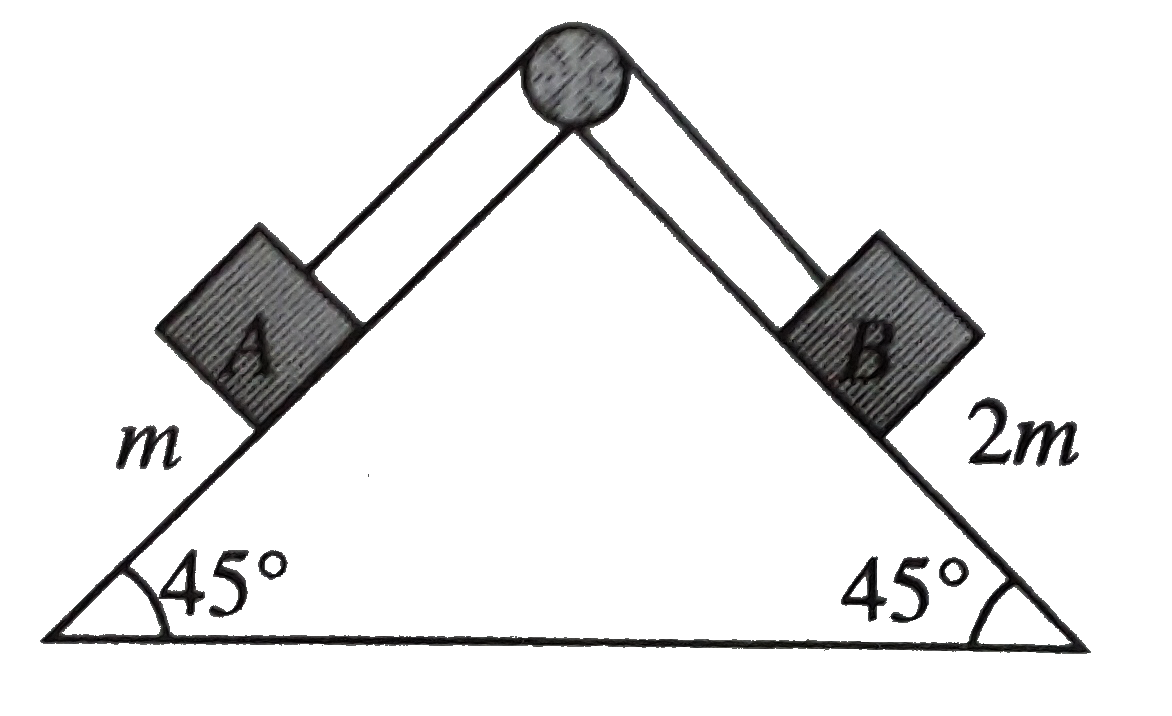
The magnitude and direction of the force of friction acting on A are
View SolutionA block of mass `10kg` is kept on a rought floor .The coefficient of friction between floor and block are `mu_(s)= 0.4` and `mu_(k) = 0.3` forces` F_(1) = 5 N` and `F_(2) = a N` are applied on the block as shown in figure
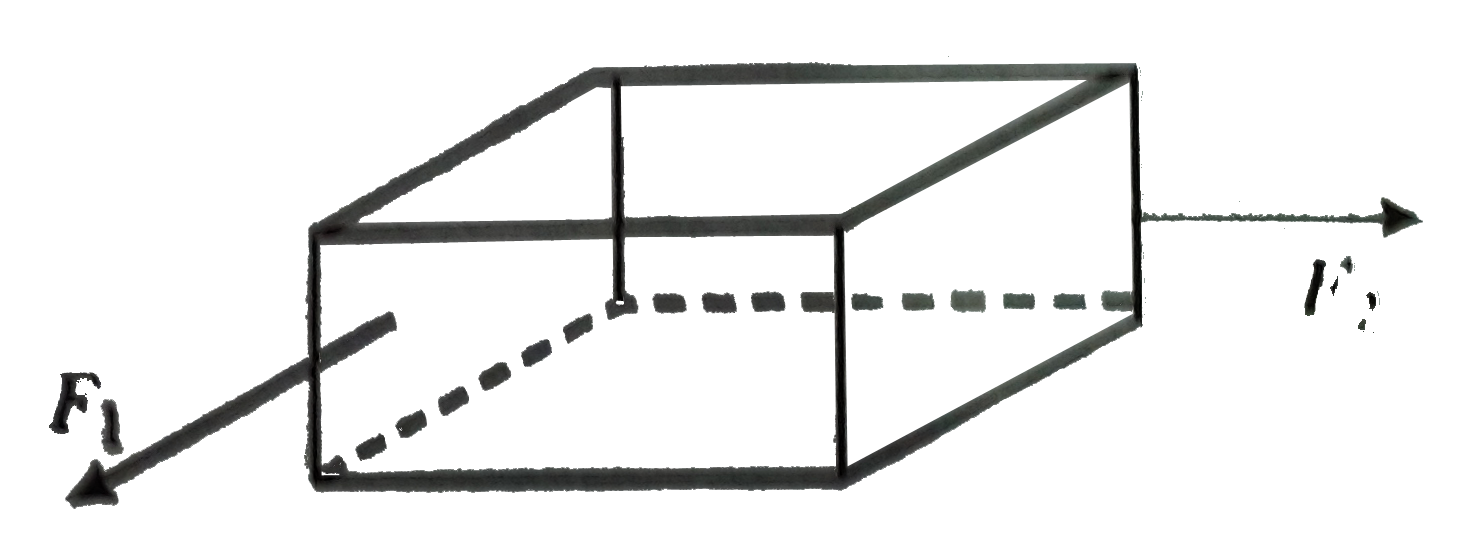
If `F_(1) = 5N` and `F_(2) = a N` for what maximum value of a the motion of block impenride?
View SolutionA block of mass `10kg` is kept on a rought floor .The coefficient of friction between floor and block are `mu_(s)= 0.4` and `mu_(k) = 0.3` forces` F_(1) = 5 N` and `F_(2) = 4 N` are applied on the block as shown in figure

If `F_(1) = 5N` and `F_(2) = a N` for what maximum value of a the motion of block impenride?
View SolutionBlock A has mass `40 kg` and B has `15 kg` and F is `500N` parallel to smooth inclined plane.The system is moving together
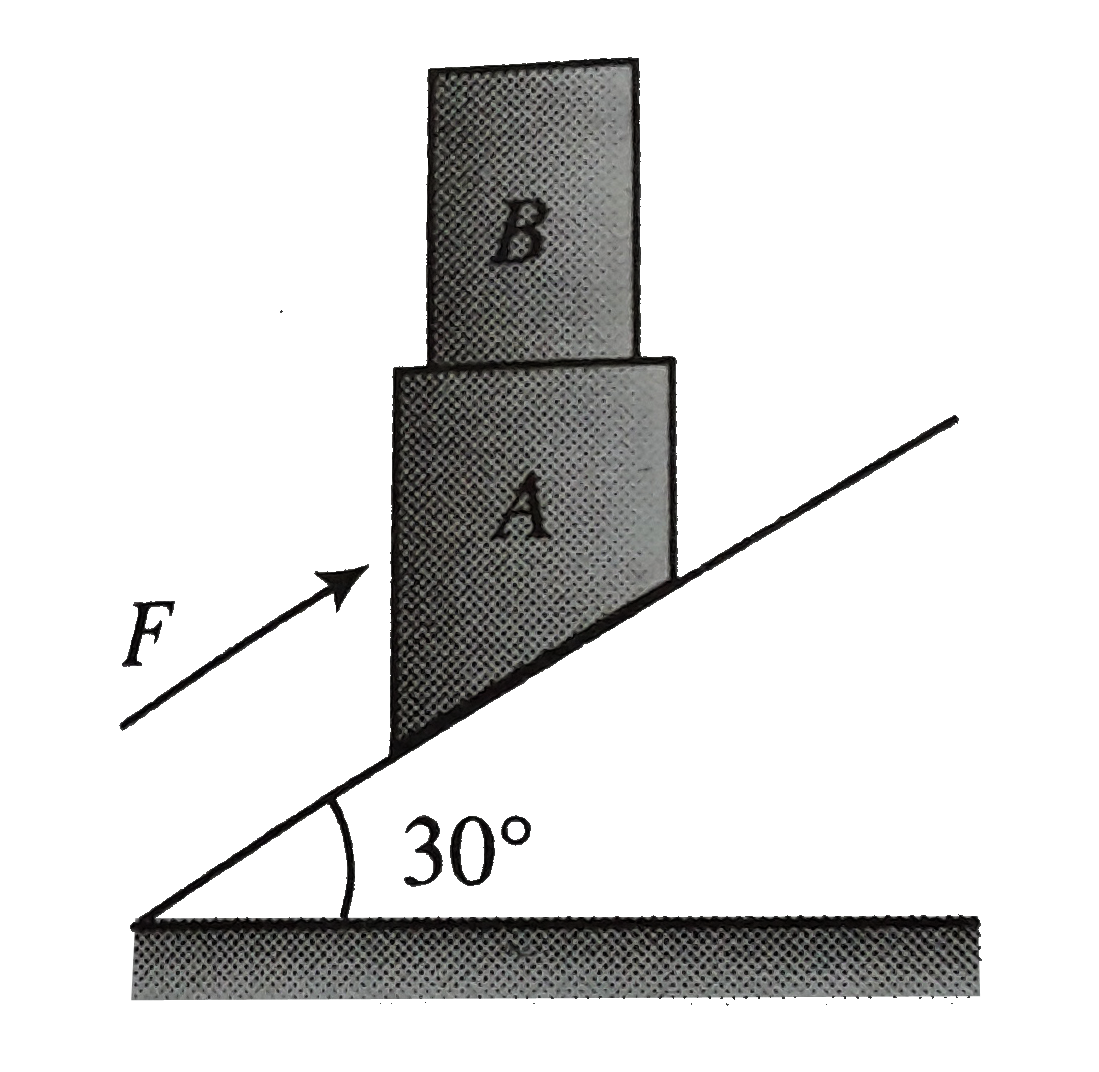
The acceleration of the system is
View SolutionBlock A has mass `40 kg` and B has `15 kg` and F is `500N` parallel to smooth inclined plane.The system is moving together
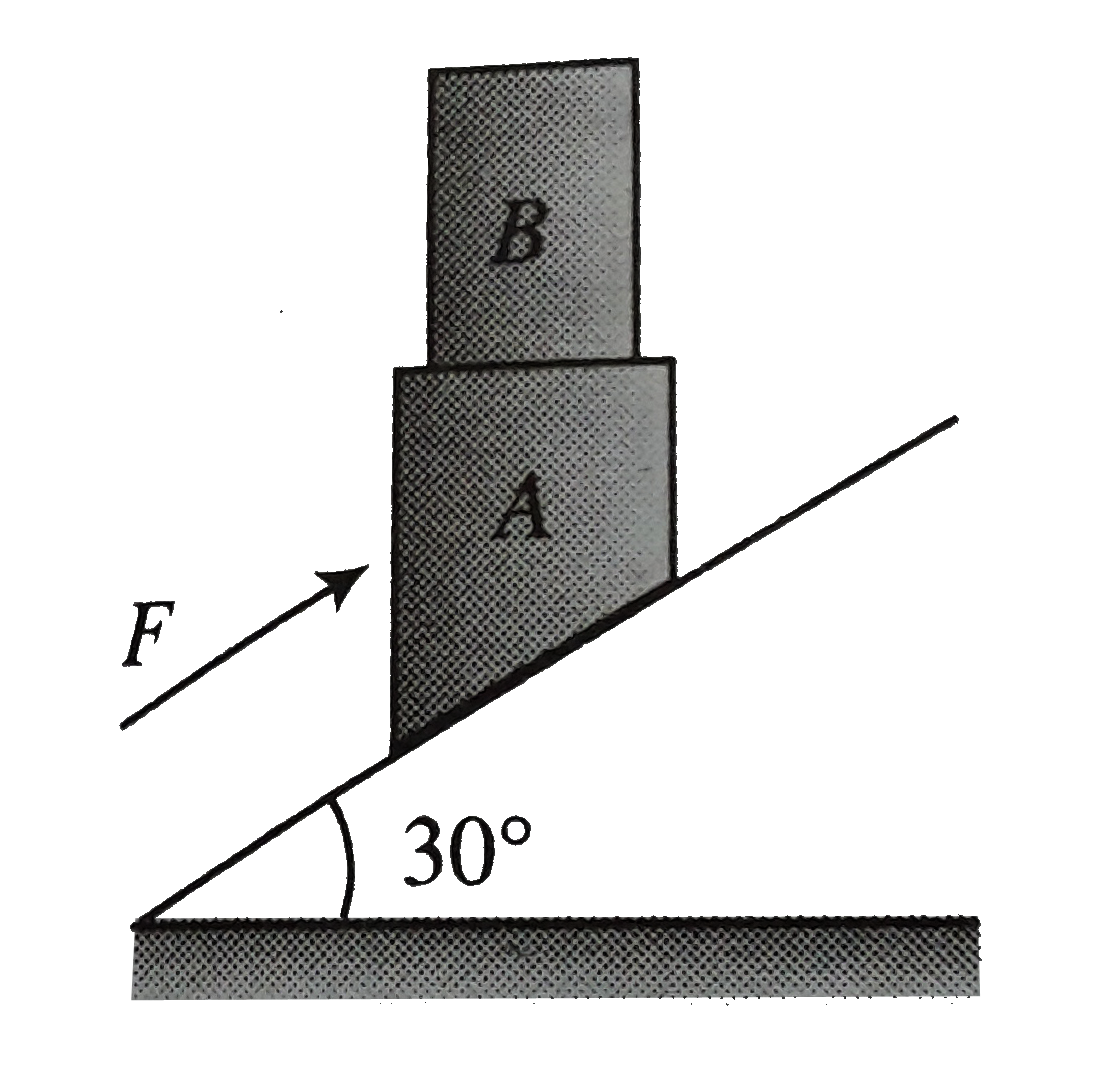
The least coefficient of friction between A and B is
View SolutionA `10kg` block rests on a `5kg` bracket as shown in figureThe `5kg` breaket rests on a horizontal surface The coefficient of frictionbetween the `10kg` block and the braket on wich it rests are `mu_(s) = 0.40 and mu_(k) = 0.30`
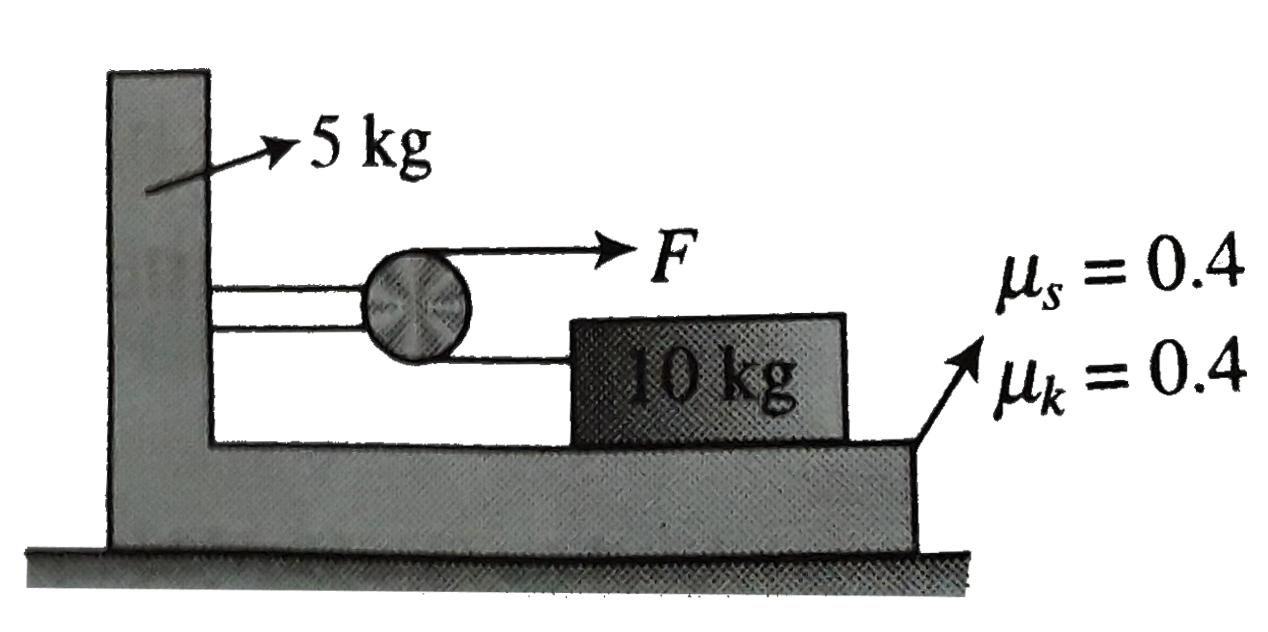
The maximum force F that can be applied if the `10 kg` block is not to slide on the braket is
View SolutionA `10kg` block rests on a `5kg` bracket as shown in figureThe `5kg` breaket rests on a horizontal surface The coefficient of frictionbetween the `10kg` block and the braket on wich it rests are `mu_(s) = 0.40 and mu_(k) = 0.30`
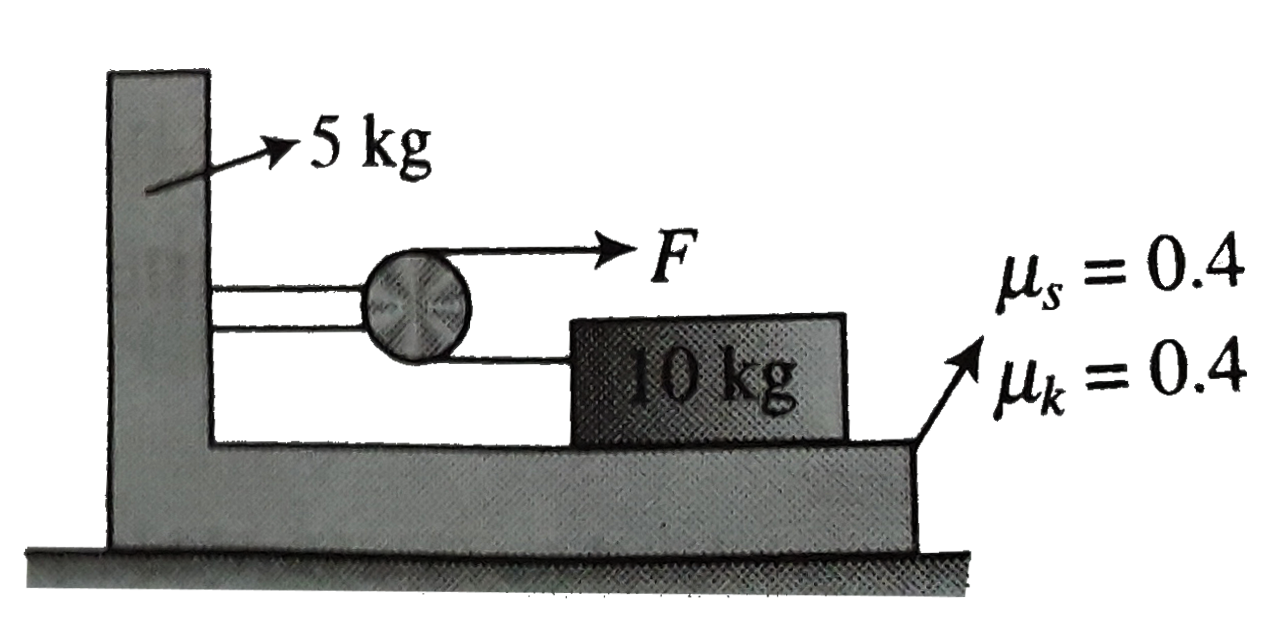
If the `10 kg` block is not to slide on the braket , the corresponding acceleration of the `5 kg` braacket is
View SolutionA sufficiently long plane of mass `4kg` is placed on a smooth horizontal surfaces A small block of mass `2kg` is placed over the plank and is beging acted upon by a time verying horizontal force `F = (0.5t)` where F is in newton and t is in second as shown in figure. The coefficient of friction slipping the plank and the block is given is `mu_(s) = mu_(k) = mu` time `t = 12s` the relative slipping between the plank and the block is just likely to accor
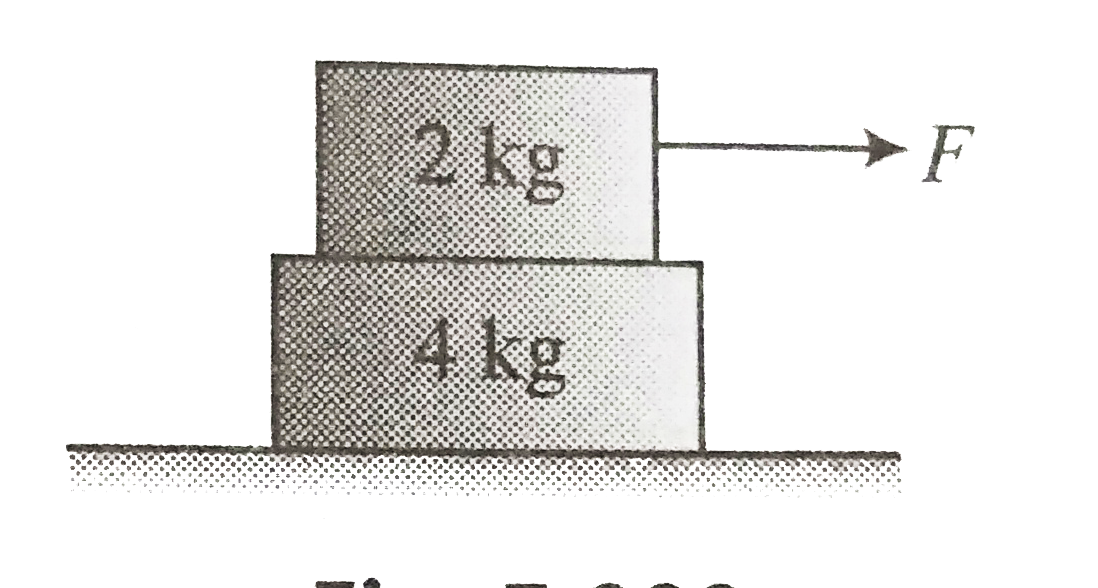
The coefficient of friction `mu` is equal to
View SolutionA sufficiently long plane of mass `4kg` is placed on a smooth horizontal surfaces A small block of mass `2kg` is placed over the plank and is beging acted upon by a time verying horizontal force `F = (0.5t)` where f is in newton and t is in second as shown in figure .The coefficient of friction slipping the plank and the block is given is `mu_(s) = mu_(k) = m`u time `t = 12s` the relative slipping between the plank and the block is just likely to accor
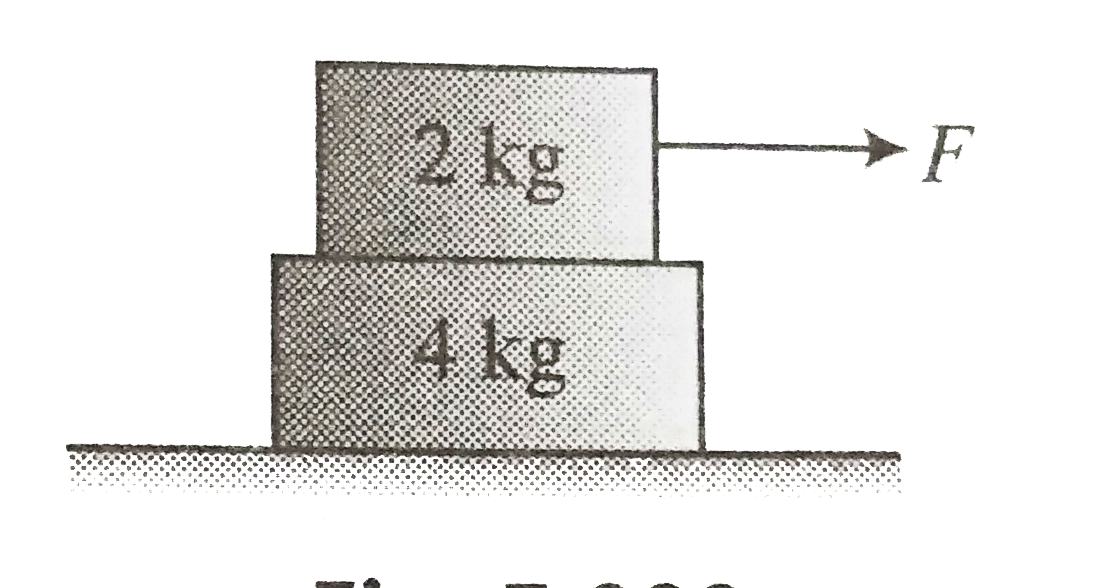
The acceleration a versus time l graph for the and the block shown in figure below is correctely represented in
View SolutionA sufficiently long plane of mass `4kg` is placed on a smooth horizontal surfaces A small block of mass `2kg` is placed over the plank and is beging acted upon by a time verying horizontal force `F = (0.5t)` where f is in newton and t is in second as shown in figure .The coefficient of friction slipping the plank and the block is given is `mu_(s) = mu_(k) = mu` time `t = 12s` the relative slipping between the plank and the block is just likely to accor
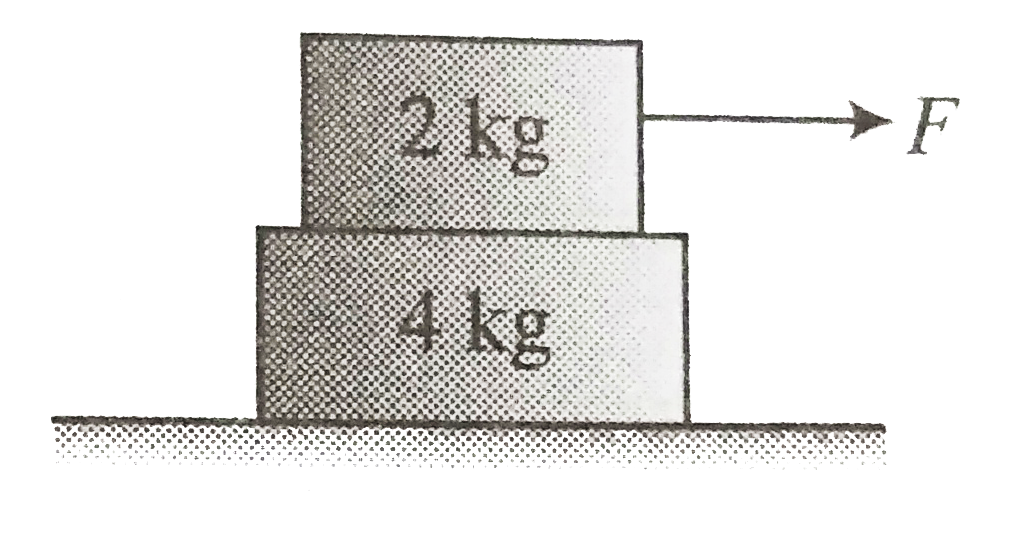
The average acceleration of the plank in the time interval `0 to 15s` in the figure will be
View SolutionA plank A of mass `M` rests on a smooth horizontal surface over which it can move without friction A cabe B of mass m lies on the plank at one edge .The coefficient of friction between the plank and the cube is `mu` The size of cube is very small in comparison to the plank.
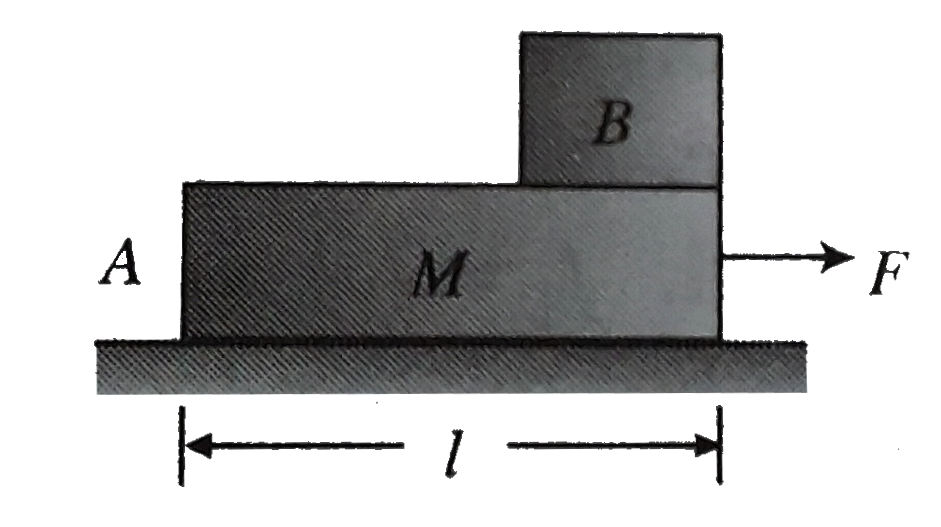
At what force `F` applied to the plank in the horizontal direction will be cube begin to slide towards the other end of the plank?
View SolutionA plank A of mass `M` rests on a smooth horizontal surface over which it can move without friction A cabe B of mass m lies on the plank at one edge .The coefficient of friction between the plank and the cube is `mu` The size of cube is very small in comparison to the plank.
In what time will the cube fall from the plank if the length of the latter is `l`?
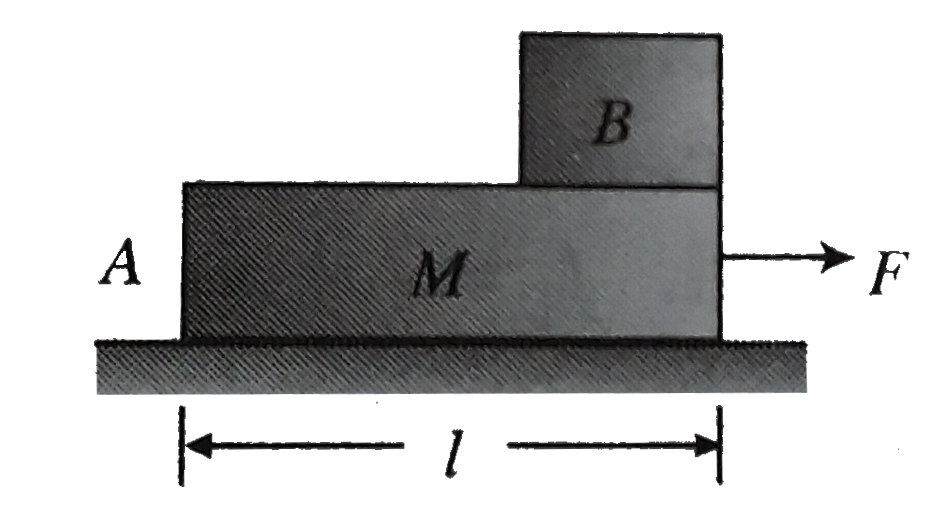
View SolutionA small block of mass m is plced over a long plank of mass M the coefficient of friction between then is `mu` .Ground is smooth At `t = 0` m is given a velocity `v_(1)` and `M` a velocity `v_(2) (gtv_(1))` as shown in Fig. After this `M` is maintained at constant celeration `a(ltmu g)`
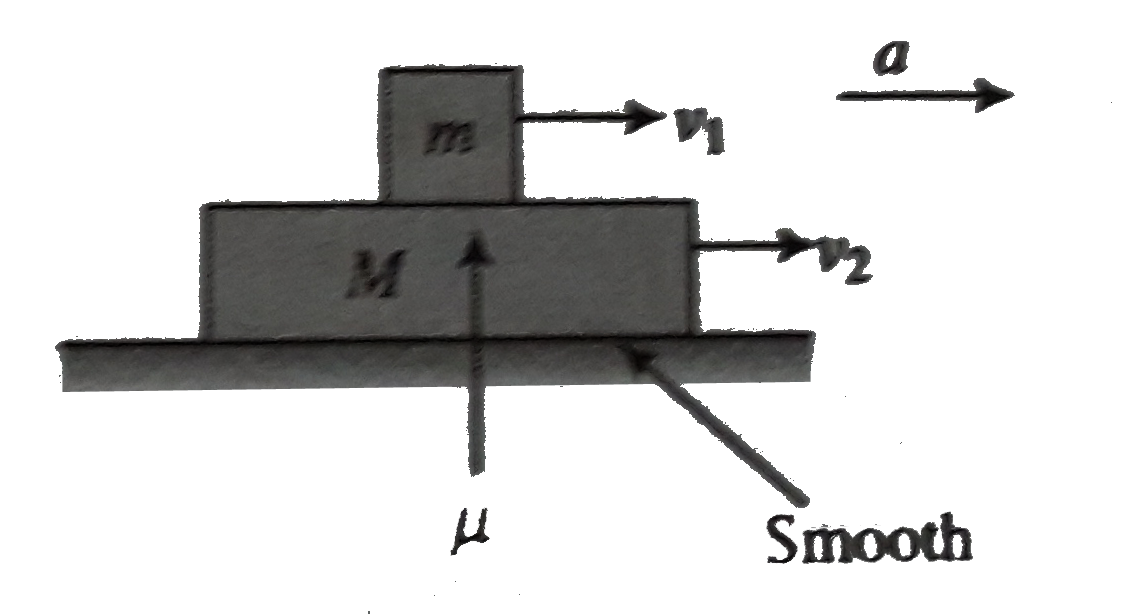
Initially there will be some relative motion between the block and the plank ,but after some time relative motion will cease and velocities of both will become
Find the time `t_(0)` when the velocities of both block and plank become same.
View SolutionA small block of mass m is plced over a long plank of mass M the coefficient of friction between then is `mu` ground is smooth At `t = 0 m` is given a velocity `v_(1)` and M a velocity `v_(2) (gtv_(1))` as shown in figure After this `M` is maintained at constant celeration `a(ltmu g)`
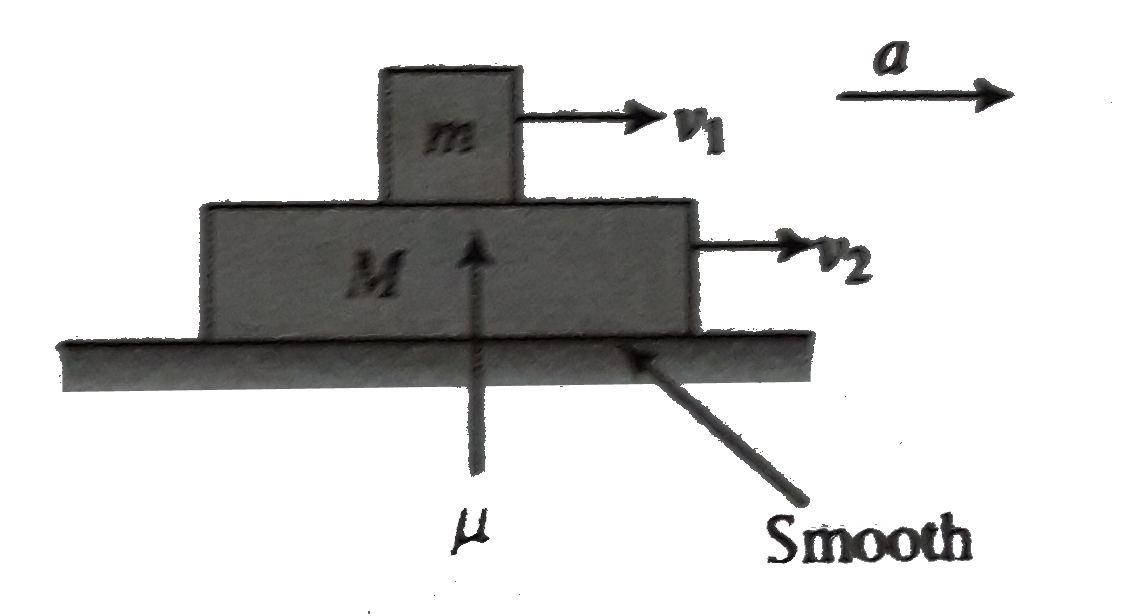
Initially there will be some relative motion between the block and the plank ,but after some time relative motion will cease and velocities of both will become
Draw the velocition of velocity of block as a function of time.
View SolutionA small block of mass m is plced over a long plank of mass M the coefficient of friction between then is `mu` ground is smooth At `t = 0` m is given a velocity `v_(1)` and M a velocity `v_(2) (gtv_(1))` as shown in figure After this M is maintained at constant celeration `a(ltmu g)`
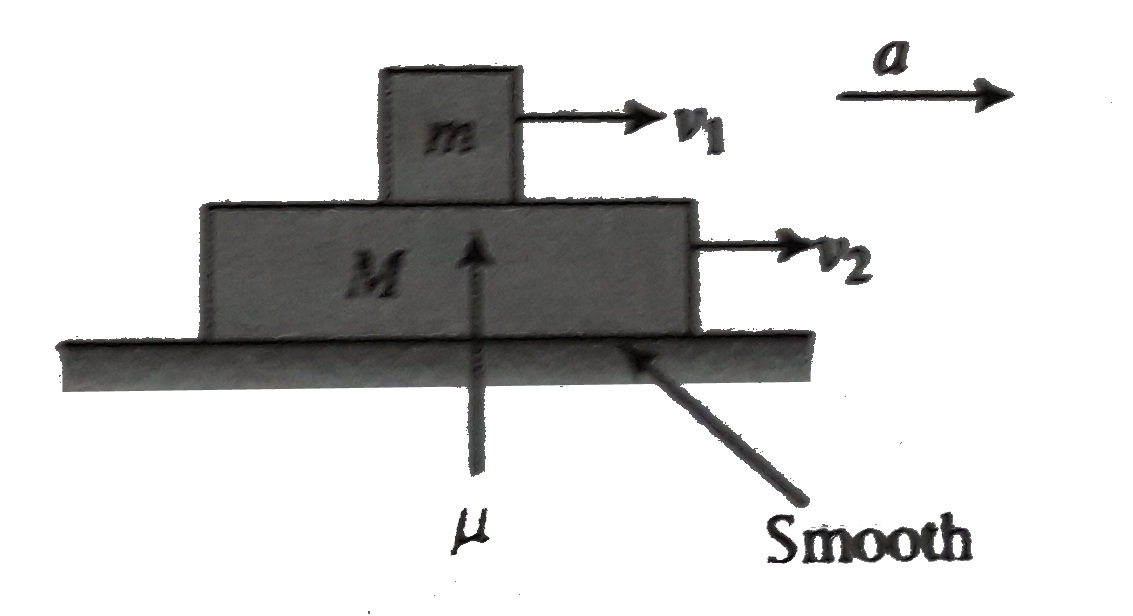
Initially there will be some relative motion between the block and the plank ,but after some time relative motion will cease and velocities of both will become
Find the forward force acting on the plank before after `t_(0)` respectively.
View SolutionA block of mass `4kg` pressed againest a rought wall by two perpendicular horizontal forces `F_(1) and F_(2)`as shown in figure Coefficient of static friction between the block and wall is `0.6` and that of kinetic friction is `0.5`
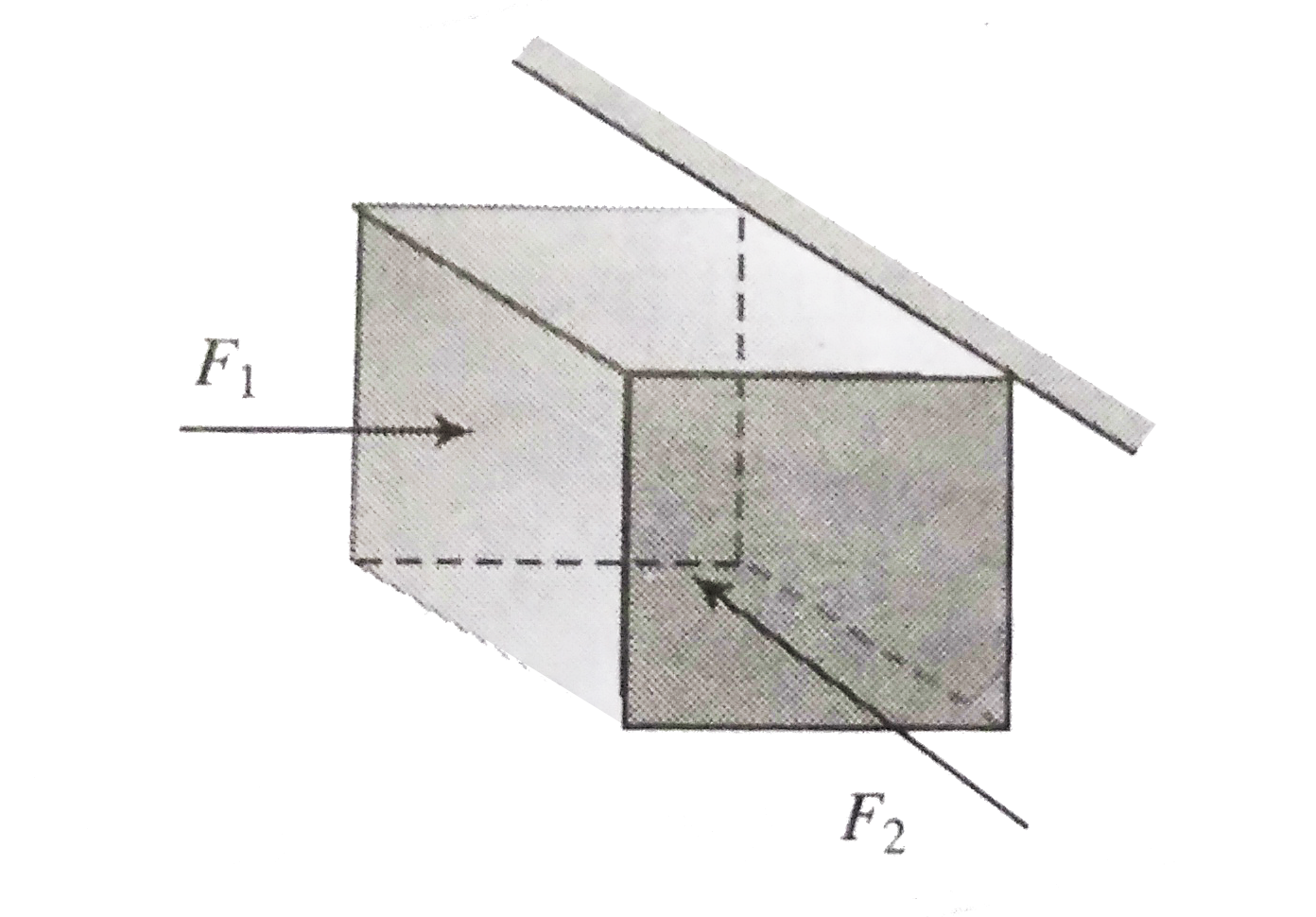
For `F_(1) = 300 N and F_(2) = 100 N` find the direction and magnitude of friction force acting on the block
View SolutionA block of mass `4kg` pressed againest a rought wall by two perpendicular horizontal forces `F_(1) and F_(2)`as shown in figure Coefficient of static friction between the block and wall is `0.6` and that of kinetic friction is `0.5`
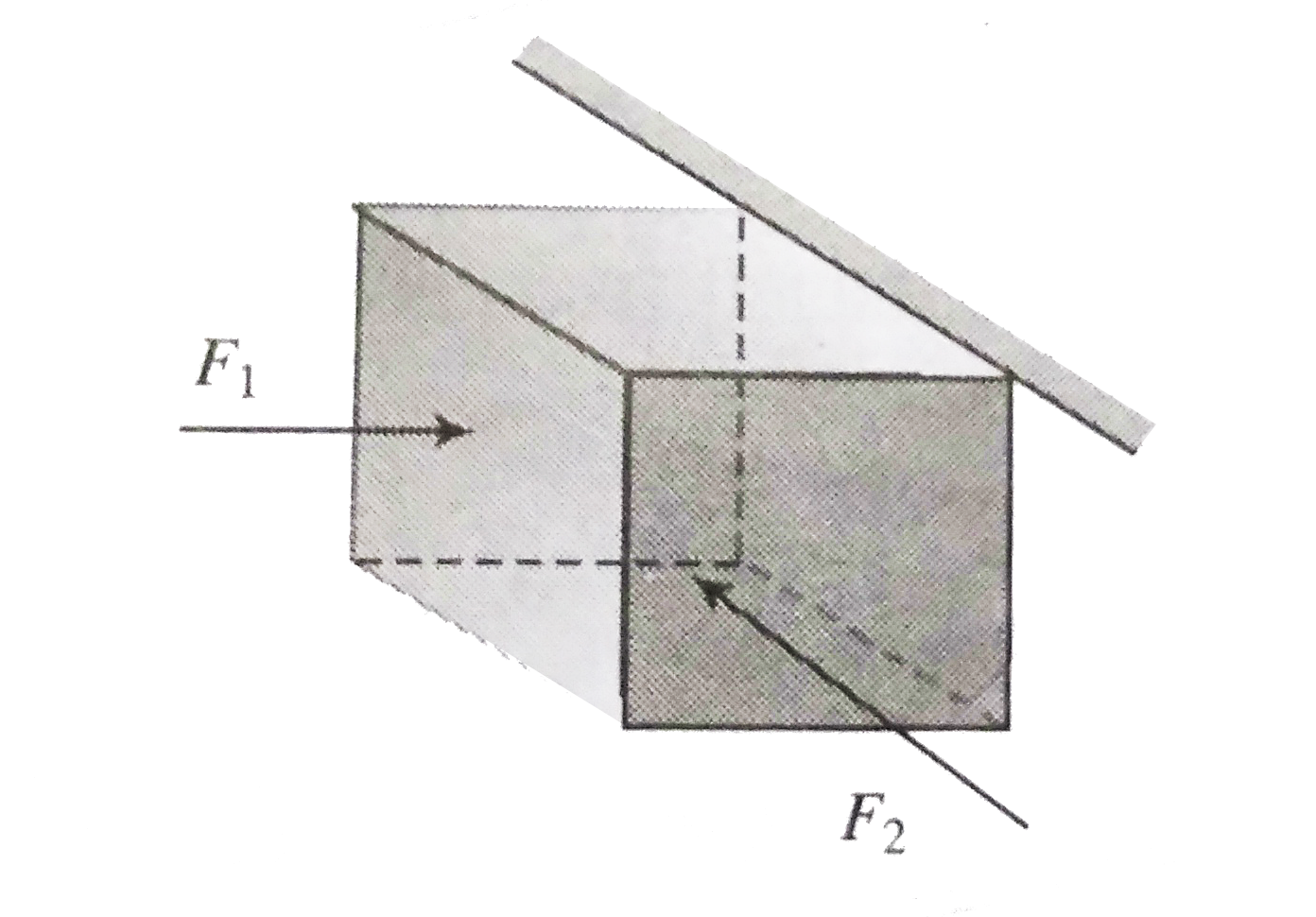
For the above data, what is the acceleration of block?
View SolutionA block of mass `4kg` pressed againest a rought wall by two perpendicular horizontal forces `F_(1) and F_(2)`as shown in figure Coefficient of static friction between the block and wall is `0.6` and that of kinetic friction is `0.5`
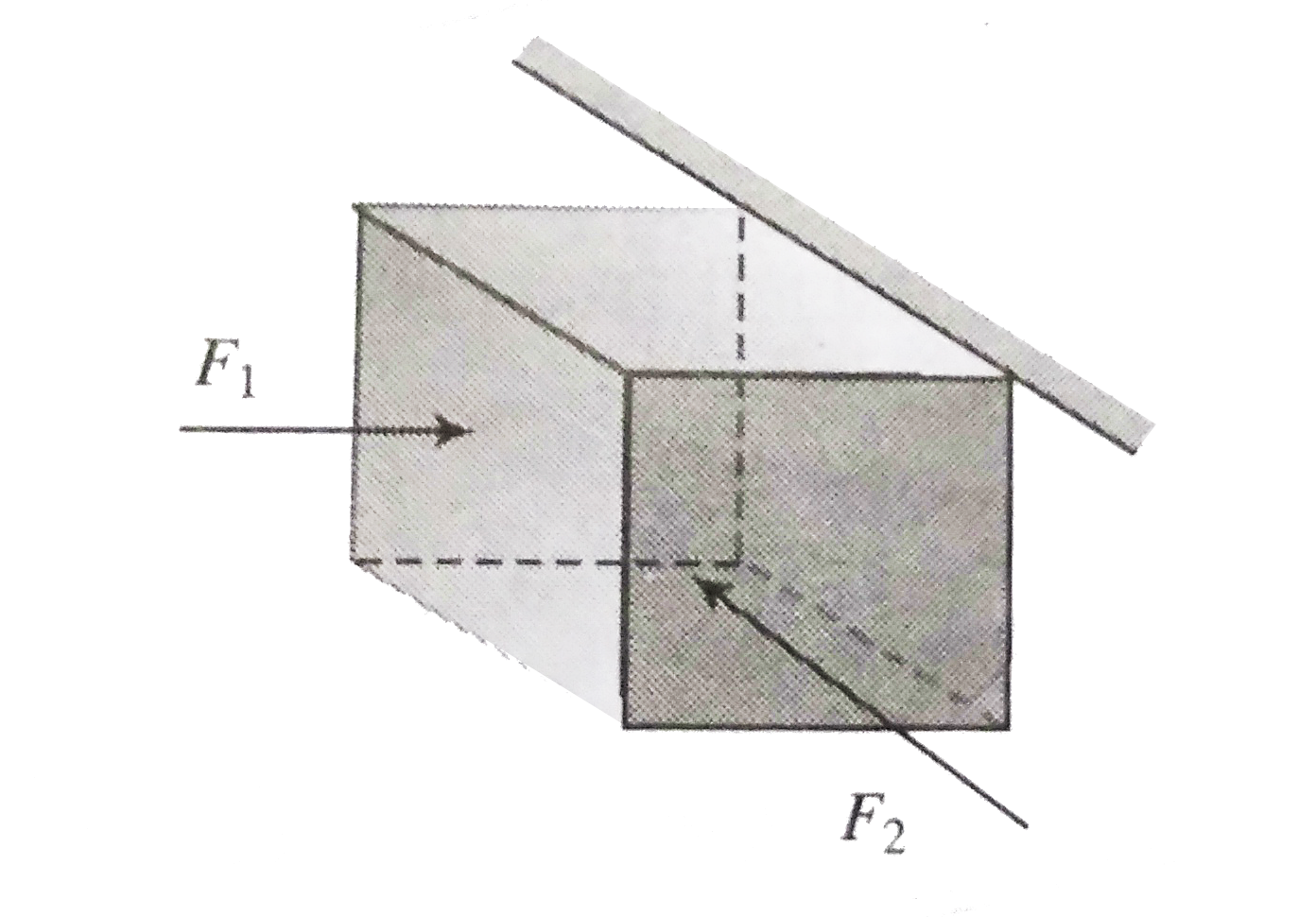
For `F_(1) = 150 Nand F_(2) =100 N` find the direction and magnitude of friction acting on the block
View SolutionA block of mass `4kg` pressed againest a rought wall by two perpendicular horizontal forces `F_(1) and F_(2)`as shown in figure Coefficient of static friction between the block and wall is `0.6` and that of kinetic friction is `0.5`
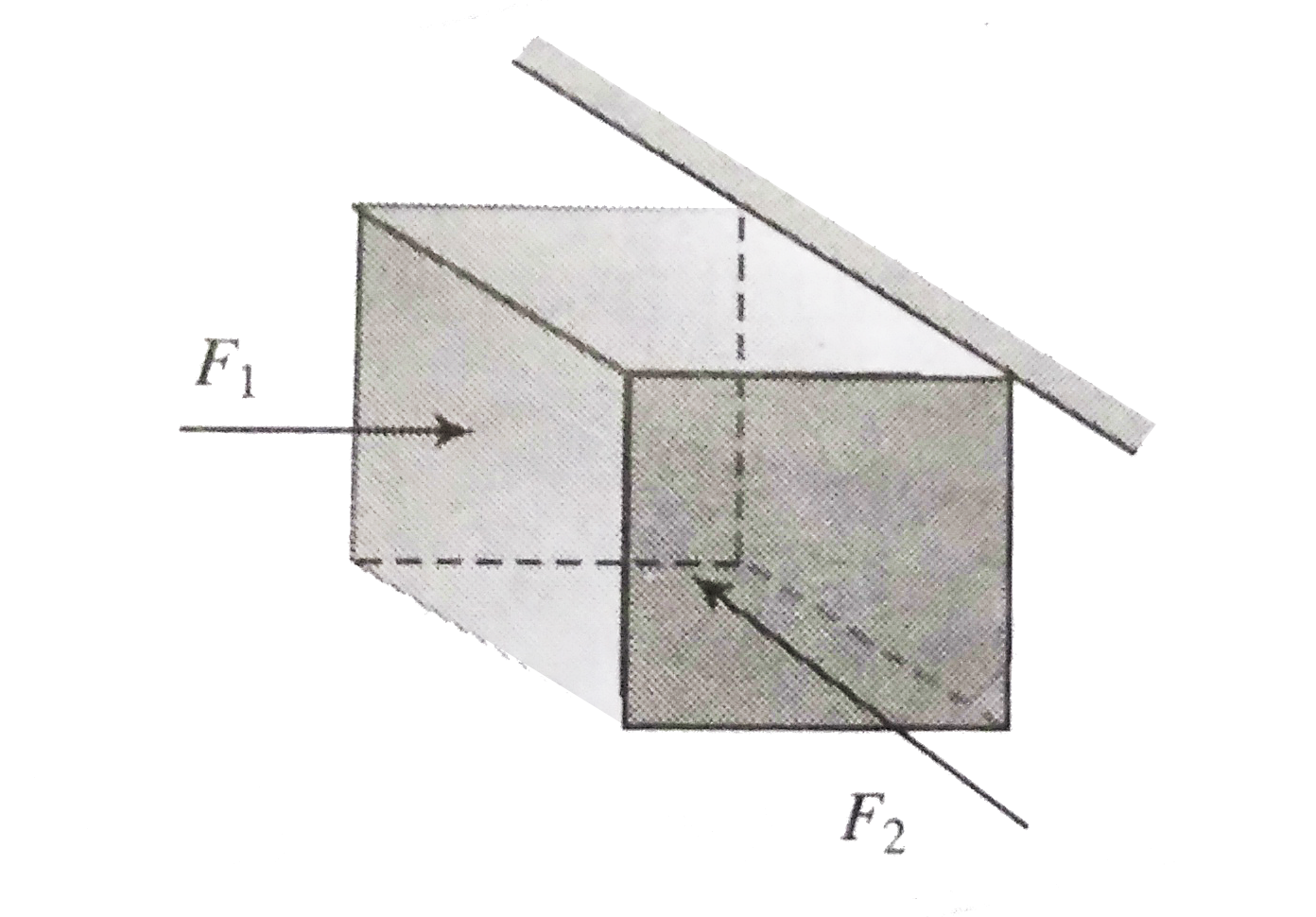
For the data of Q 28 ,Find the magnitude of acceleration of the block
View SolutionA system of two blocks and a light string are kept on two inclined force (rought) as shown in figure All the are mentioned in the diagram pulley is light and frictionless `(Take g = 10ms^(-2) , sin 37^(@) = 3//5)`
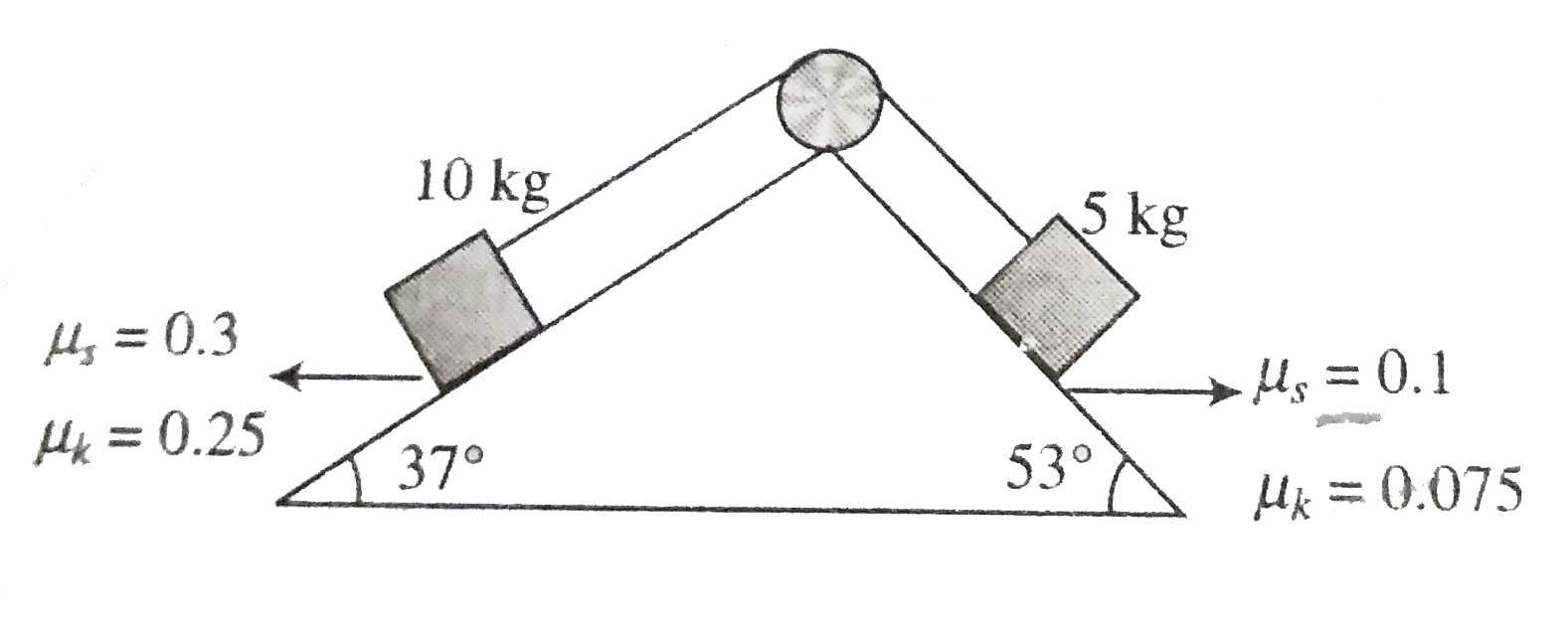
If the system force rest , then the acceleration of the system is
View SolutionA system of two blocks and a light string are kept on two inclined force (rought) as shown in figure All the are mentioned in the diagram pulley is light and frictionless `(Take g = 10ms^(-2) , sin 37^(@) = 3//5)`
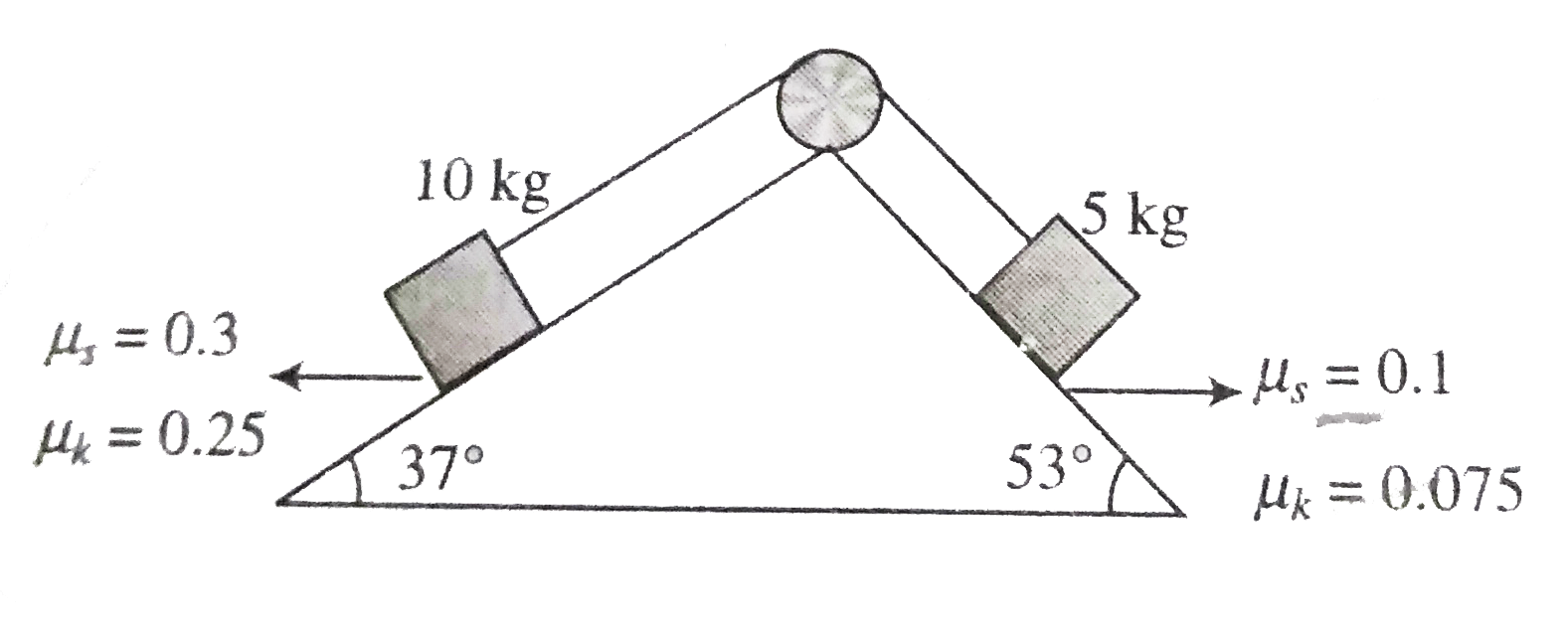
If a system moving in such away that a block of `10 kg` is comming down inclined with a speed of `2 ms^(-2)`then how much time the system takes to come to a stop? [Assume the length of incline to be large enough]
View SolutionA system of two blocks and a light string are kept on two inclined force (rough) as shown in figure All the are mentioned in the diagram pulley is light and frictionless `(Take g = 10ms^(-2) , sin 37^(@) = 3//5)`
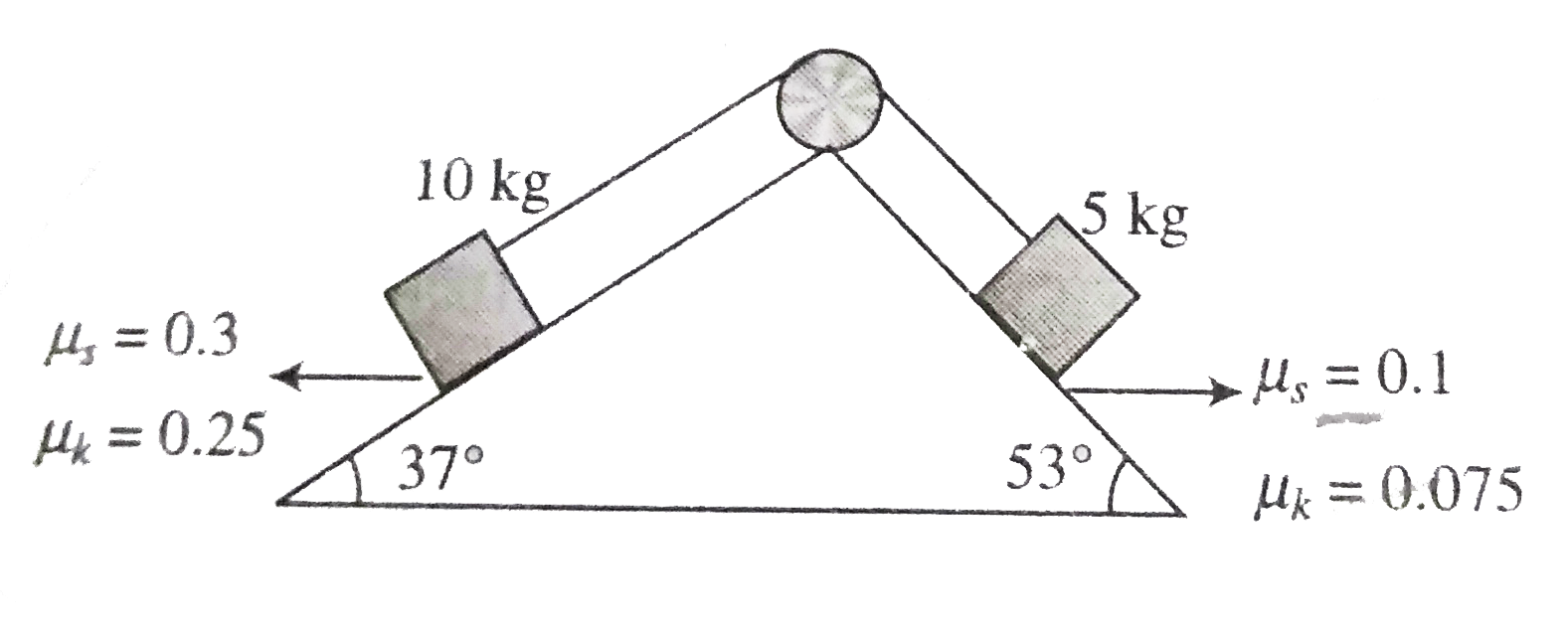
In the above question the motion of the system would be best described by
View SolutionA system of two blocks is placed on a rought horizontal surface as shown in figure below The coefficient of static and kinetic friction at two surfaces are shown A force F is horizontal applied on the upper block as shown . Let `f_(1) ,f_(2)` represent the frictional force between upper and lower surface of contact respectively and `a_(1),a_(2)` represent the acceleration of `3kg` and `2kg` block respectively
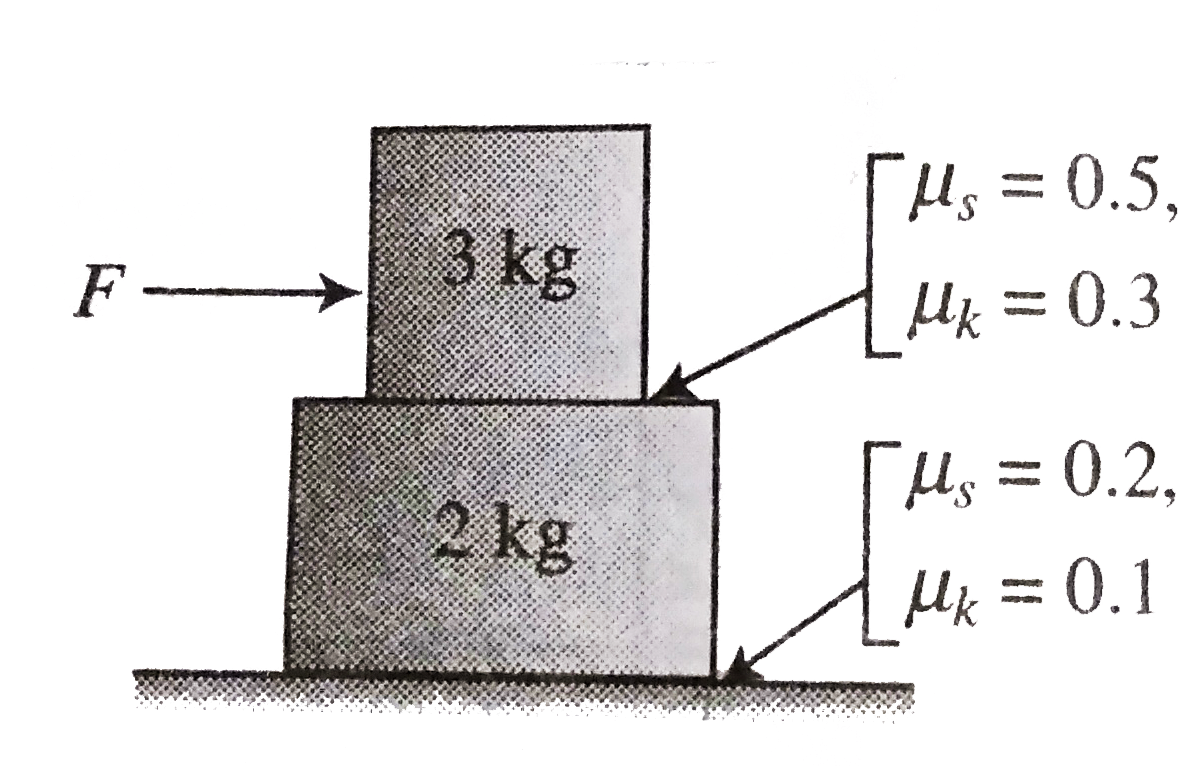
If F is gradually increasing forcethen which of the following statement (s) contact would be true?
View SolutionA system of two blocks is placed on a rought horizontal surface as shown in figure below The coefficient of staic and kinetic friction at two surfaces are shown A force F is horizontal applied on the upper block as shown .Let `f_(1) ,f_(2)` represent the frictional force between upper and lower surface of contact respectively and `a_(1),a_(2)` represent the acceleration of `3kg and 2kg` block respectively
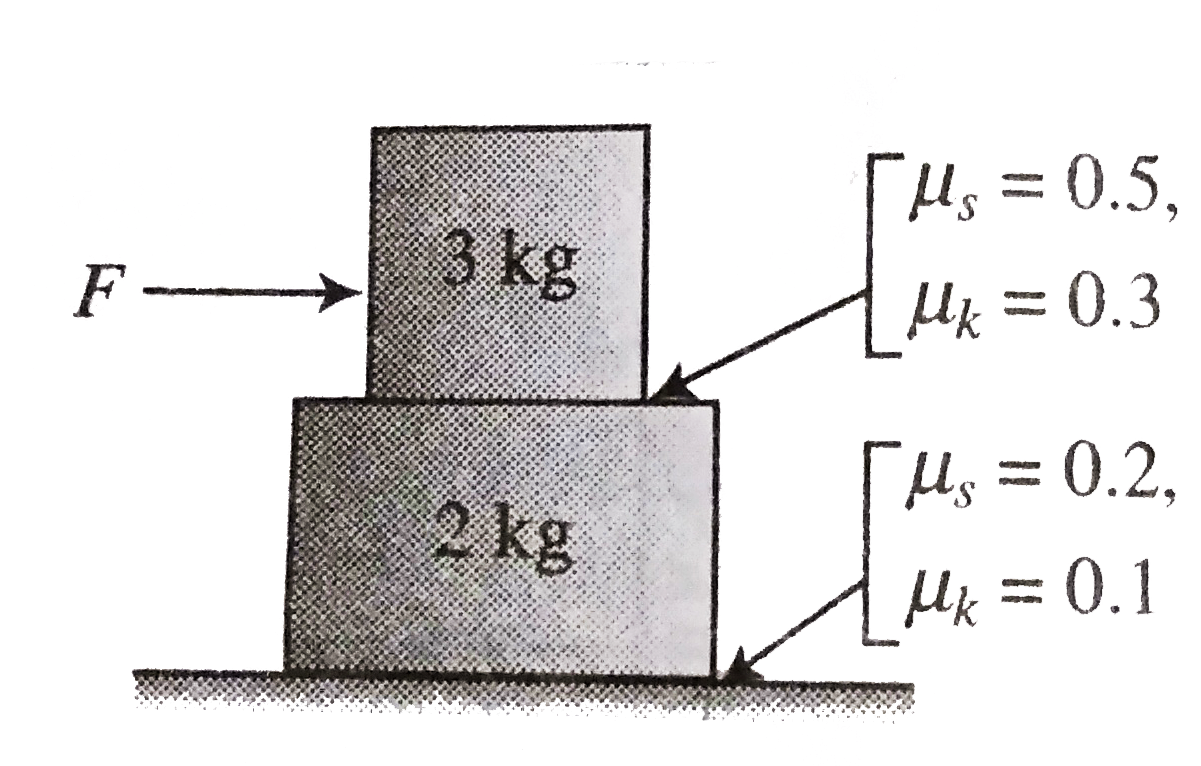
For `F= 12N` mark the correct option
View SolutionA system of two blocks is placed on a rought horizontal surface as shown in figure below The coefficient of staic and kinetic friction at two surfaces are shown A force F is horizontal applied on the upper block as shown .Let `f_(1) ,f_(2)` represent the frictional force between upper and lower surface of contact respectively and `a_(1),a_(2)` represent the acceleration of `3kg and 2kg` block respectively
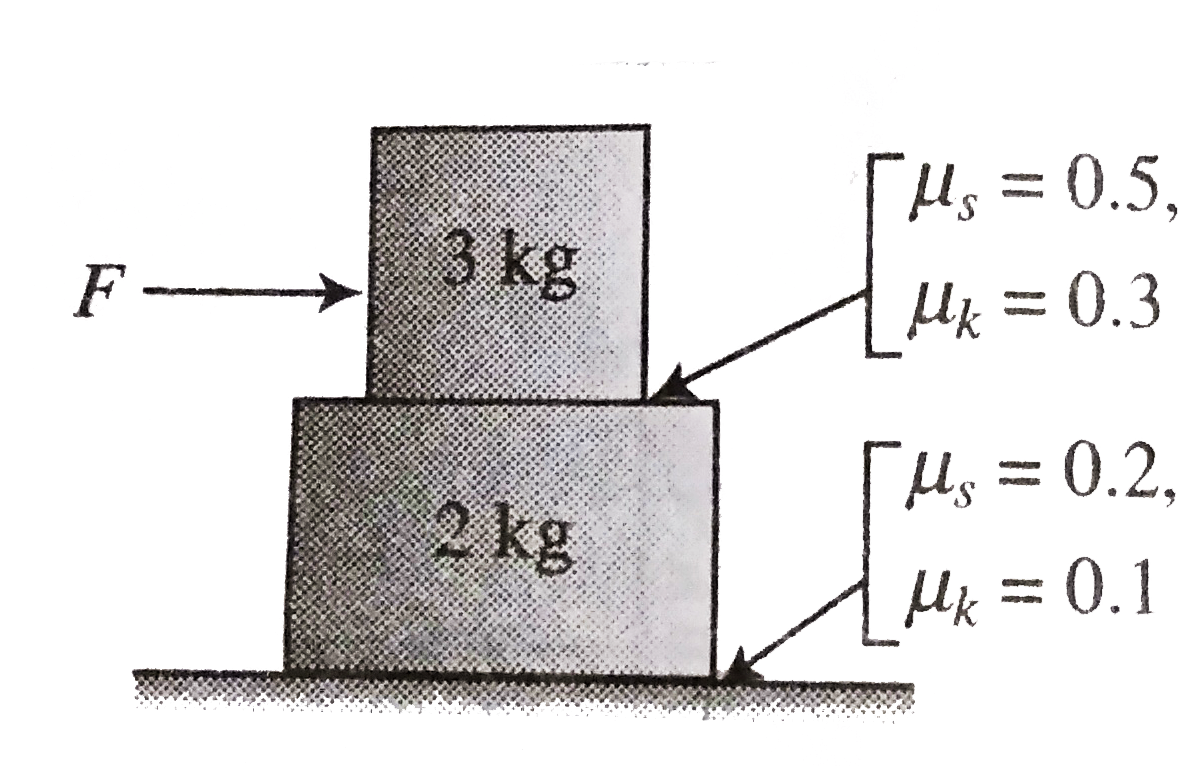
For relative motion to be there between two blocks the minimum value of F should be
View SolutionTwo bodies A and B of masses `10 kg` and `5 kg` placed very slightly seperated as shown in figure The coefficient of friction between the floor and the block are as `mu_(s) = 0.4` block A is pushed by an external force F The value of F can be changed when the weight between block A and ground breaks block A will start prssing block B will start pressing the vertical wall
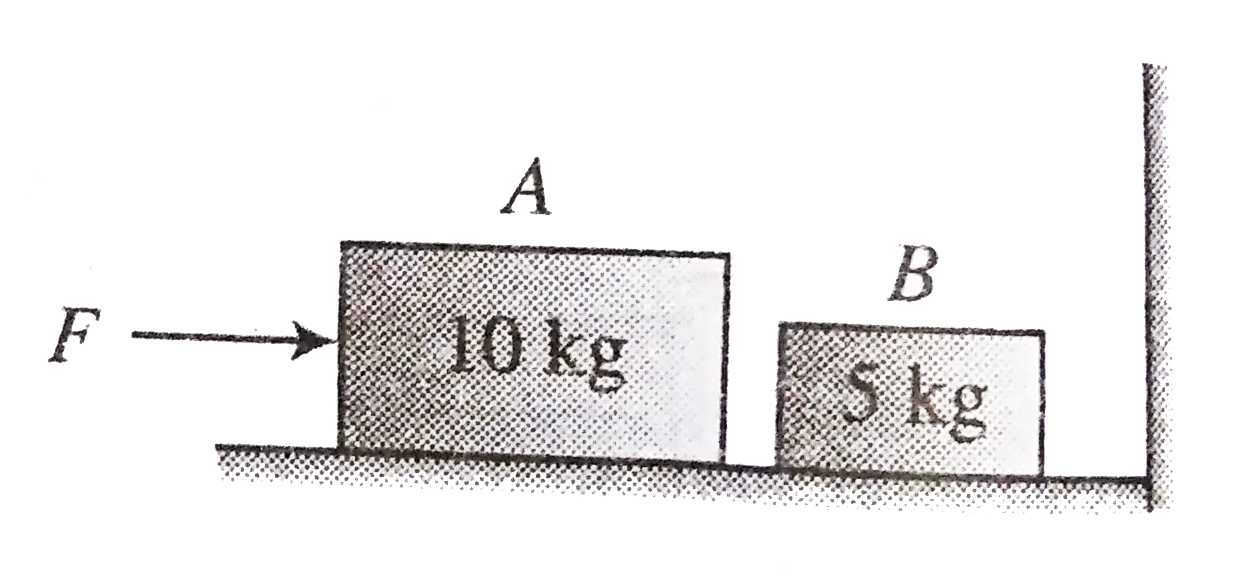
If `F = 20N`,with how much force block A press block B?
View SolutionTwo bodies A and B of masses `10 kg and 5 kg` placed very slightly separated as shown in figure The coefficient of friction between the floor and the block are as `mu_(s) = 0.4` block A is pushed by an external force F The value of F can be changed when the weight between block A and ground breaks block A will start pressing block B will start pressing the vertical wall
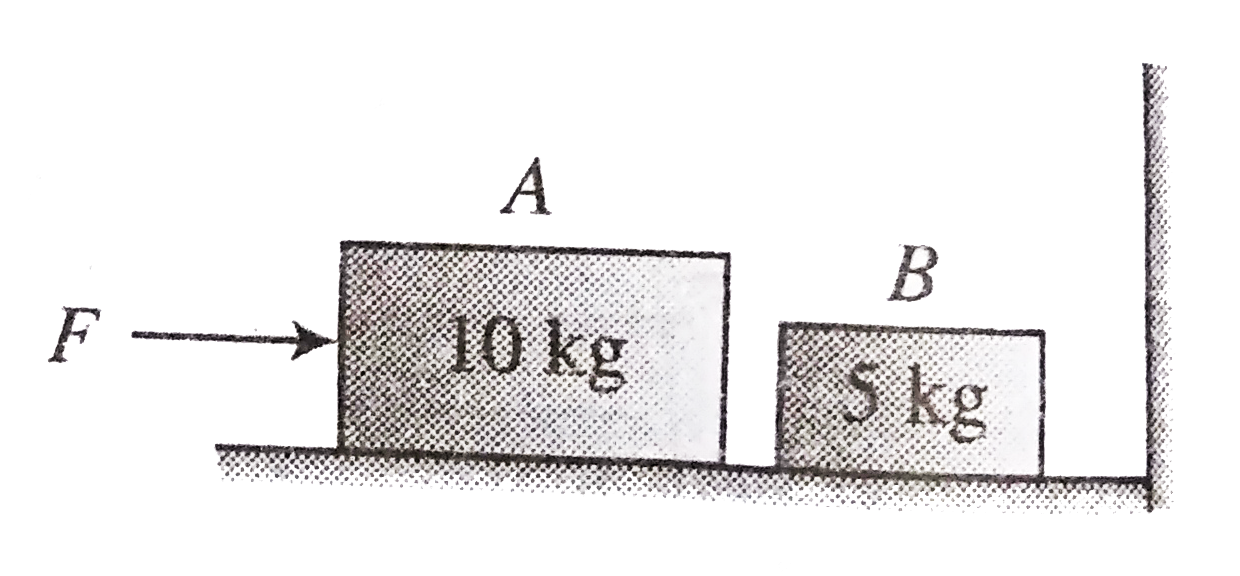
If `F = 50N `, the friction force acting between block B and ground will be
View SolutionTwo bodies A and B of masses `10 kg and 5 kg` placed very slightly seperated as shown in figure The coefficient of friction between the floor and the block are as `mu_(s) = 0.4` block A is pushed by an external force F The value of F can be changed when the weight between block A and ground breaks block A will start prssing block B will start pressing the vertical wall
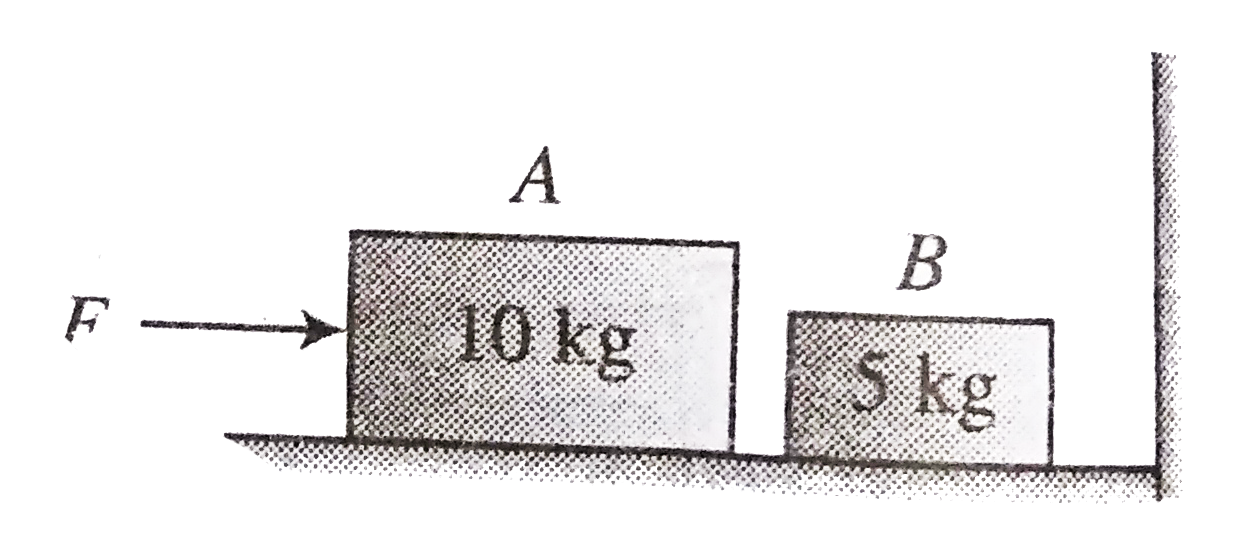
The force of friction acting on B verius with the applied force F acceleration to curve
View SolutionOn a stationary block of mass `2kg` a horizontal forces F starts acting at `t = 0` whose veriation with time is shown in figure .The coefficient of friction between the block and ground is `0.5` New answer the following question
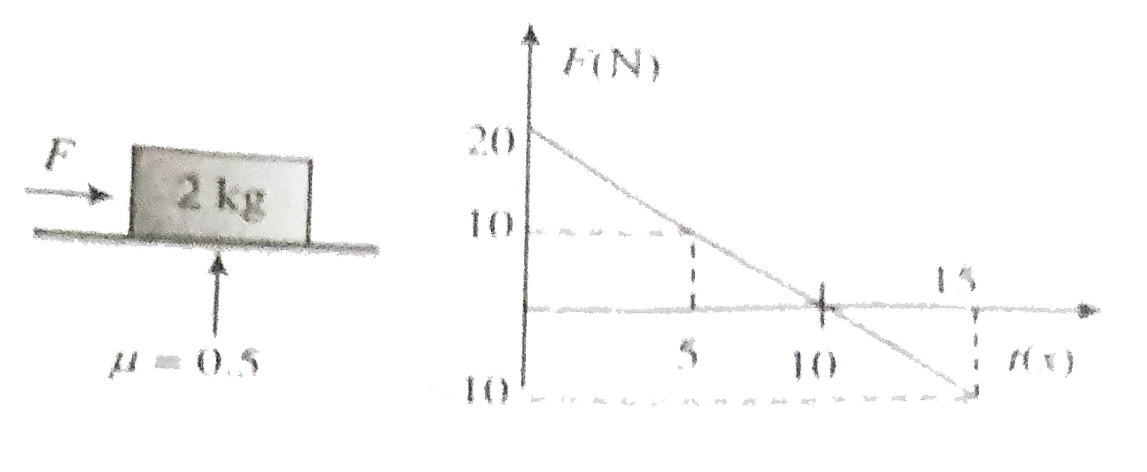
Find the time when acceleration of the block is zero
View SolutionOn a stationary block of mass `2kg` a horizontal forces F starts acting at `t = 0` whose veriation with time is shown in figure .The coefficient of friction between the block and ground is `0.5` New answer the following question
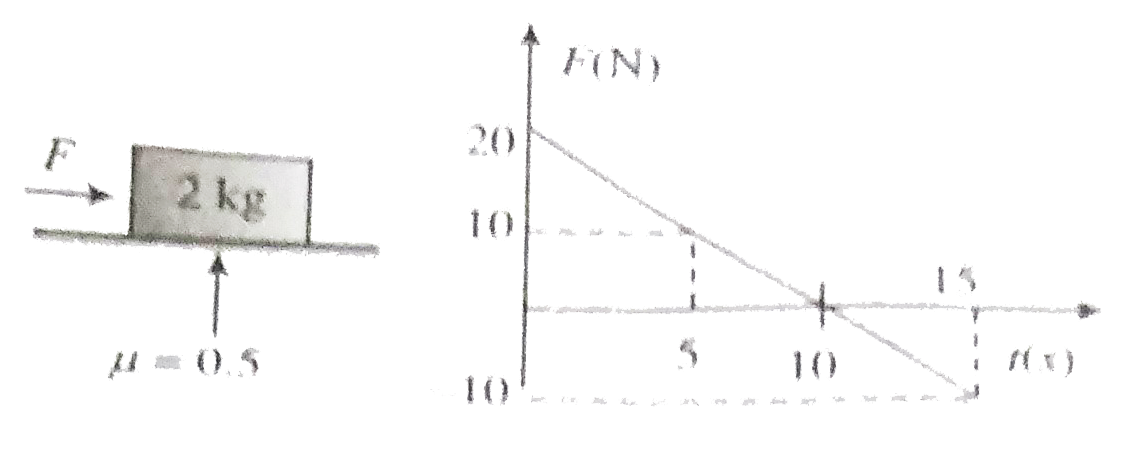
Find the velocity of the block when for the firsst time its acceleration become zero
View SolutionOn a stationary block of mass `2kg` a horizontal forces F starts acting at `t = 0` whose veriation with time is shown in figure .The coefficient of friction between the block and ground is `0.5` New answer the following question
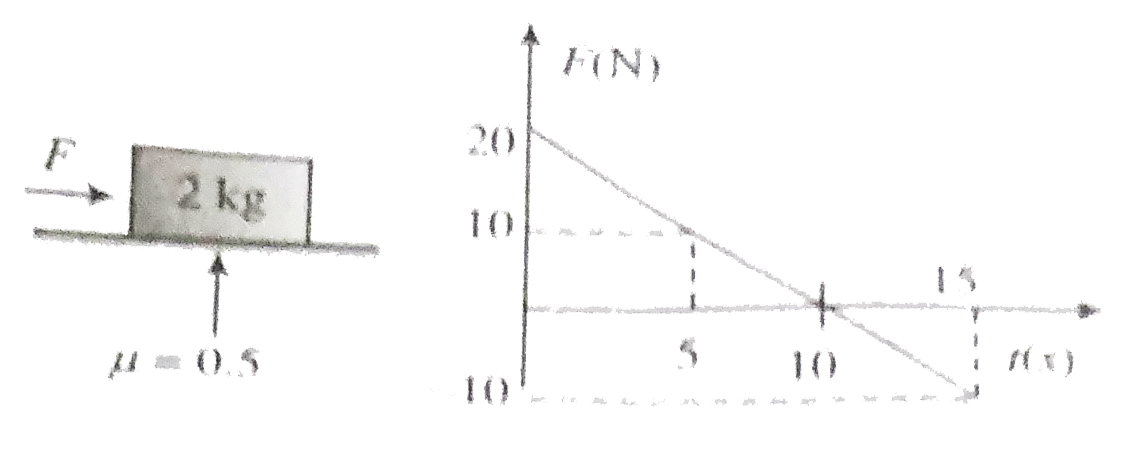
Find the velocity of the at `t = 12s`
View SolutionA long conveyer belt moves with a constant velocity of `8 ms^(-1)`.Two blockA and B each of mass `2kg` are placed gently on the belt with B on A, initail velocity of block is zero Coefficient of friction between A and belt is `0.1` There is no friction between A and B length of A is `4m`
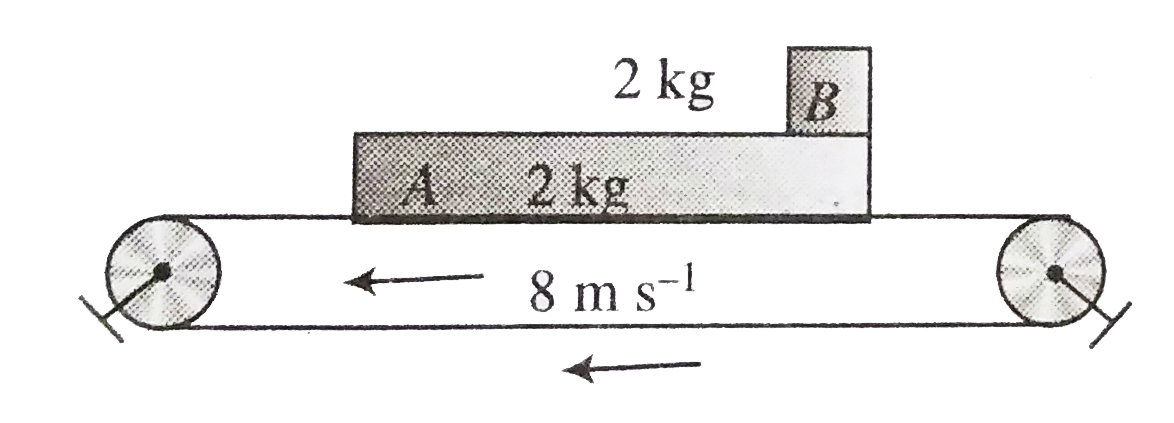
Find the time when A falls off A initially ,B is no the right and of A lgnore the dimensions of B
View SolutionA long conveyer belt moves with a constant velocity of `8 ms^(-1)`.Two blockA and B each of mass `2kg` are placed gently on the belt with B on A, initail velocity of block is zero Coefficient of friction between A and belt is `0.1` There is no friction between A and B length of A is `4m`
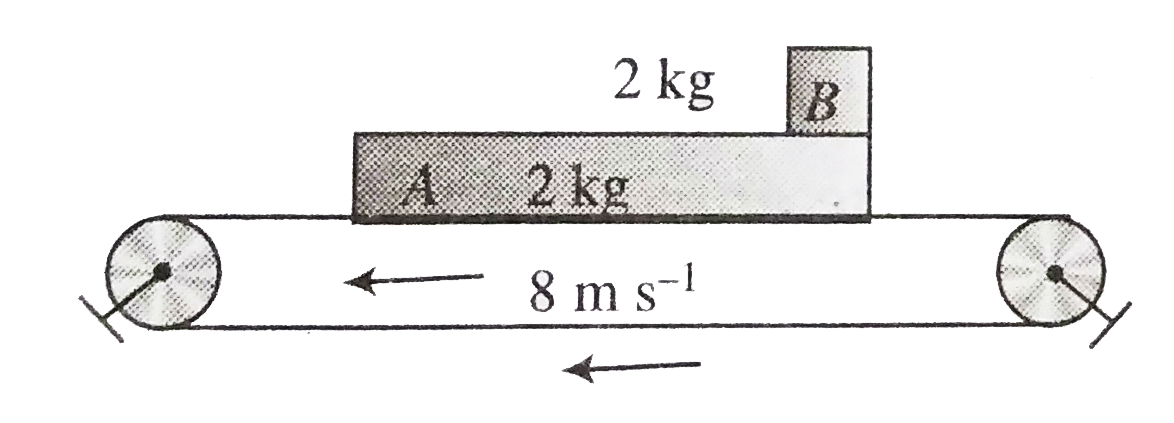
Find the velocity of A when B falls off A
View SolutionA long conveyer belt moves with a constant velocity of `8 ms^(-1)`.Two blockA and B each of mass `2kg` are placed gently on the belt with B on A, initail velocity of block is zero Coefficient of friction between A and belt is `0.1` There is no friction between A and B length of A is `4m`
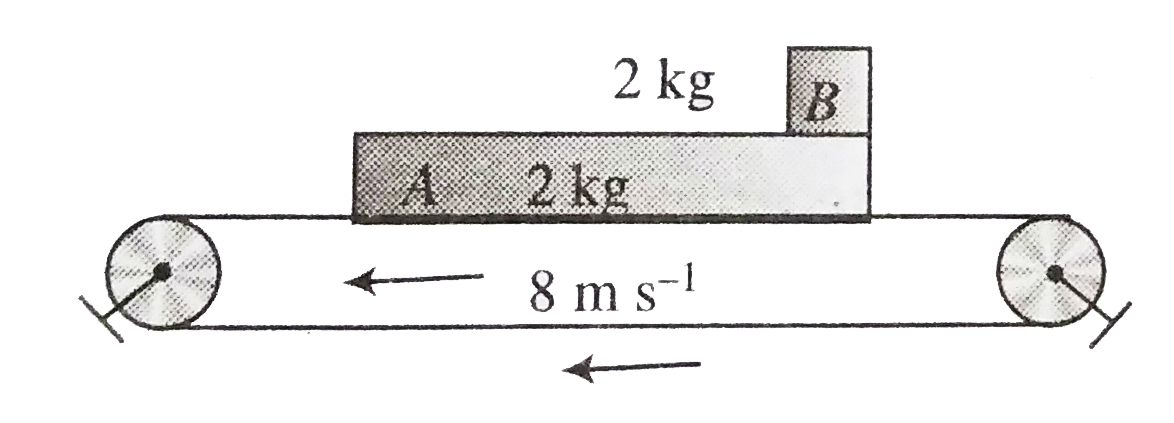
If the coefficient of friction between the block B and belt is `0.4` Find the separation between the two block when B come to rest w.r.t. belt
View SolutionTwo smooth blocks of masses m and m' connected by a light inextensible strings are moving on a smooth wedge of mass M. If a force F acts on the wedge the blocks do not slide relative to the wedge. Find the (a) acceleration of the wedge and (b) value of F.
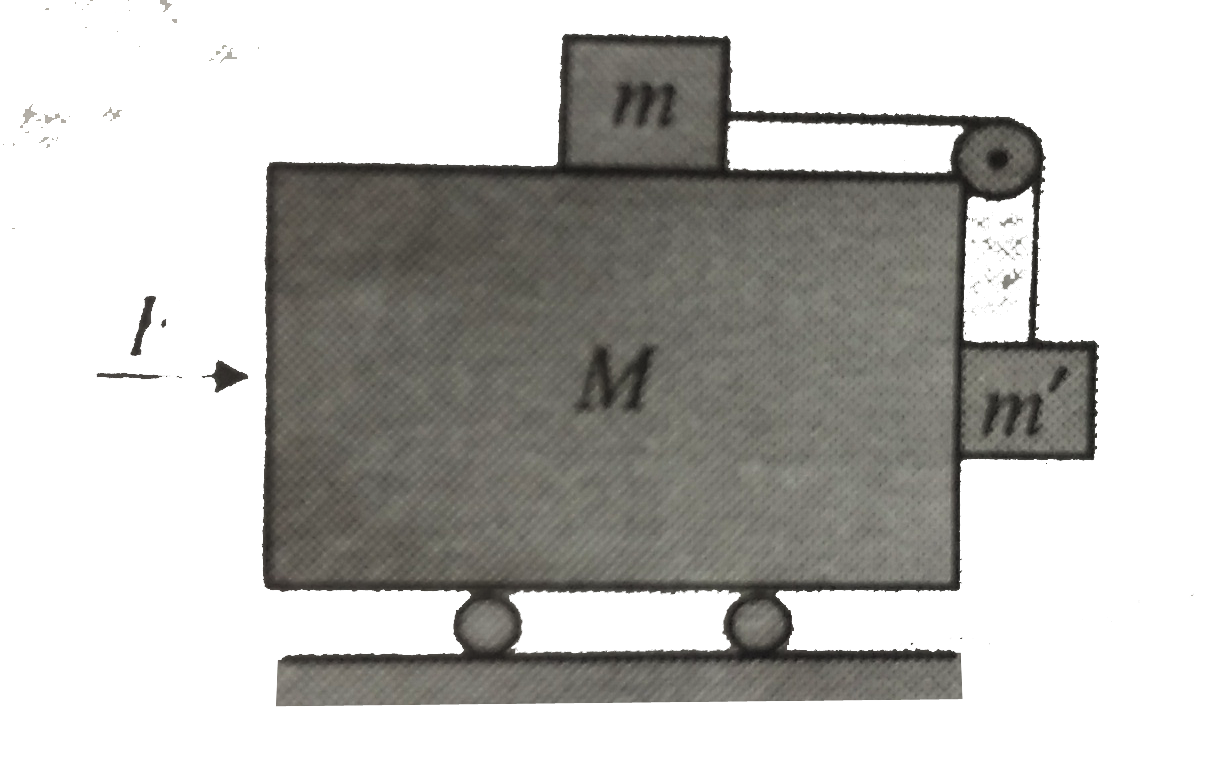
View SolutionTwo smooth blocks of masses m and m' connected by a light inextensible strings are moving on a smooth wedge of mass M. If a force F acts on the wedge the blocks do not slide relative to the wedge. Find the (a) acceleration of the wedge and (b) value of F.

View SolutionA person of mass `75 kg` works in a where his job is to arrange heavy articles in a stone - room As shown in figure he place a packing of mass `20 kg` on a ramp that is inclined to the horizontal at `37^(@)` and pushed it up the ramp with an acceleration `1.5ms^(-2)` .This is the minimum acceleration for the packege to reach the top to the ramp.THe coefficient of static and friction between the shoes of the person and the ground is `0.8` and coefficient of kinetic friction for the motion of package on the is `0.5`
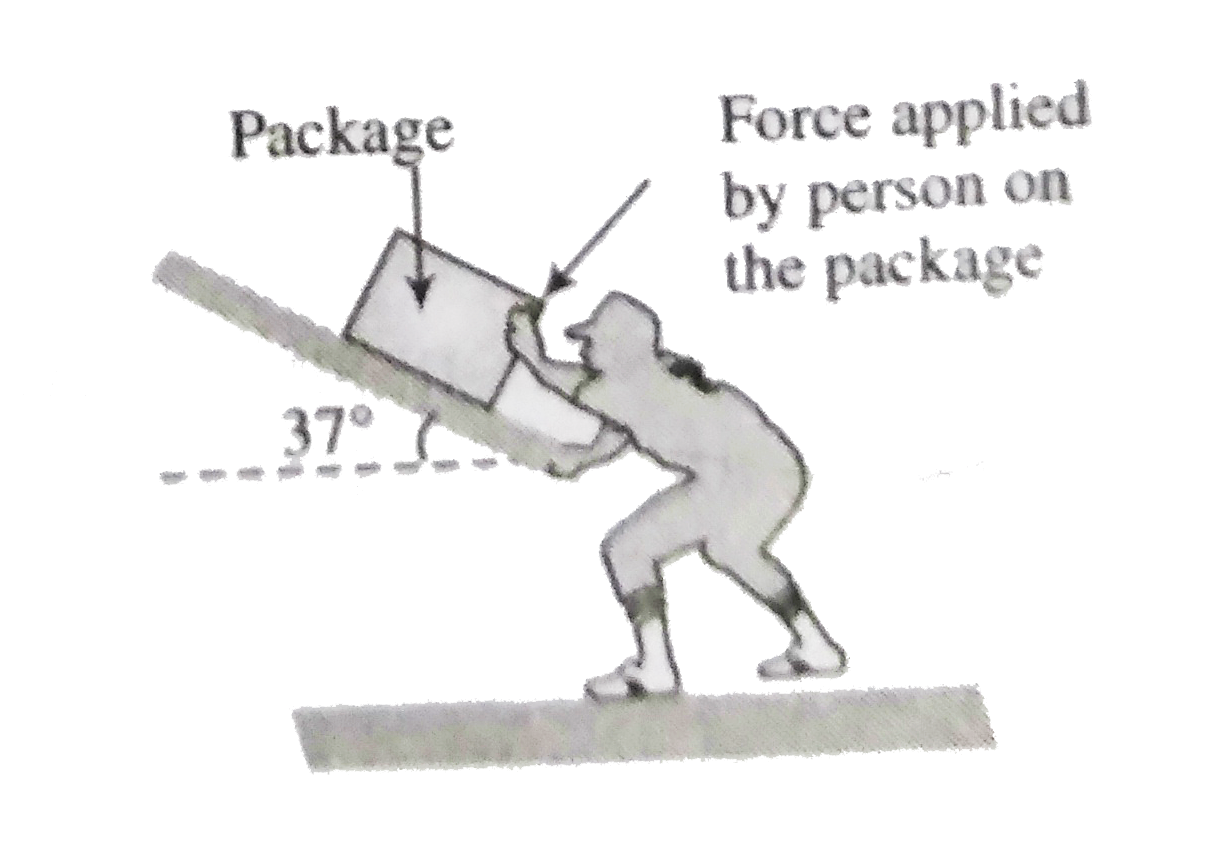
Force applied by the person on the package is
View SolutionA person of mass `75 kg` works in a where his job is to arrange heavy articles in a stone - room As shown in figure he place a packing of mass `20 kg` on a ramp that is inclined to the horizontal at `37^(@)` and pushed it up the ramp with an acceleration `1.5ms^(-2)` .This is the minimum acceleration for the packege to reach the top to the ramp.THe coefficient of static and friction between the shoes of the person and the ground is `0.8` and coefficient of kinetic friction for the motion of package on the is `0.5`
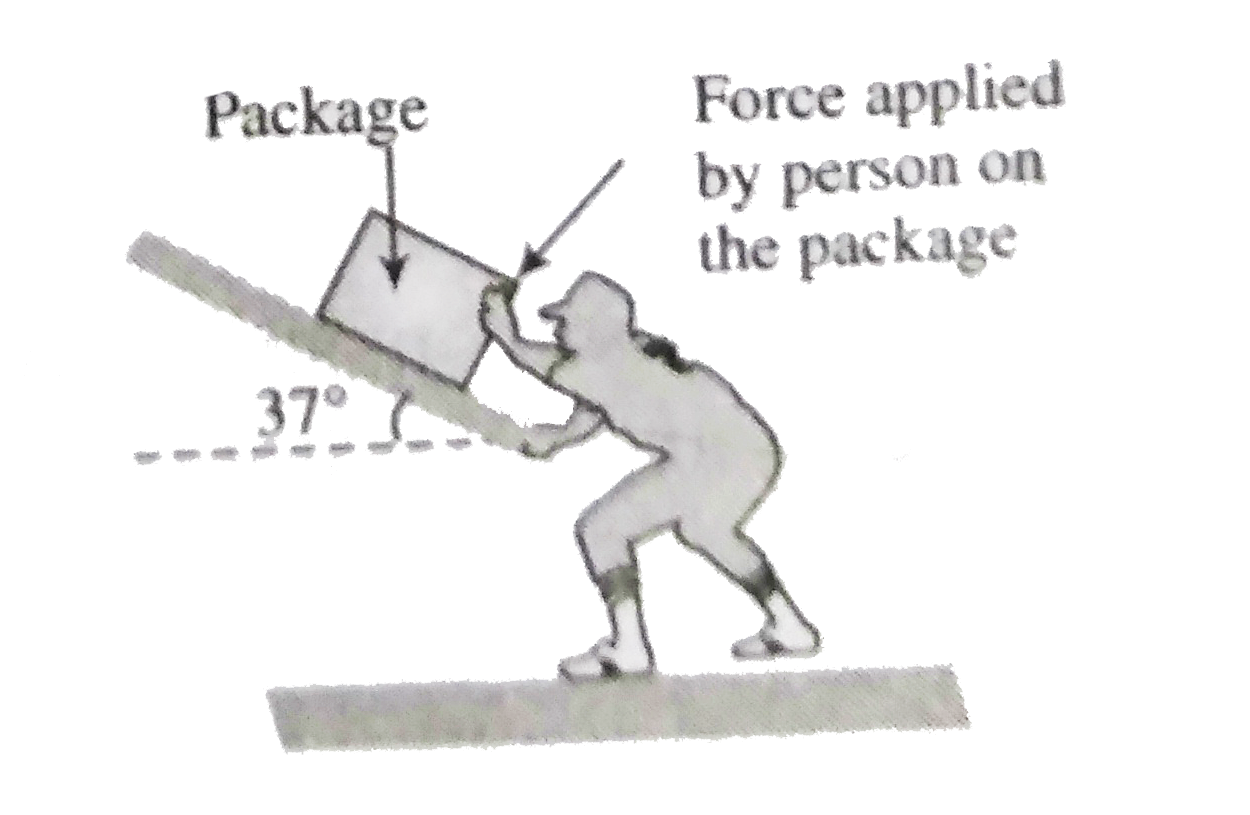
Force of friction acting on the person is
Now suppose that the ground is wet which reduces the coefficient of static friction between the shoes of the person and the ground of `0.2` (other value remaining unchanged) Answer the following question:
View SolutionA person of mass `75 kg` works in a where his job is to arrange heavy articles in a stone - room As shown in figure he place a packing of mass `20 kg` on a ramp that is inclined to the horizontal at `37^(@)` and pushed it up the ramp with an acceleration `1.5ms^(-2)` .This is the minimum acceleration for the packege to reach the top to the ramp.THe coefficient of static and friction between the shoes of the person and the ground is `0.8` and coefficient of kinetic friction for the motion of package on the is `0.5`

Force applied by the person on the package is
View SolutionA person of mass `75 kg` works in a where his job is to arrange heavy articles in a stone - room As shown in figure he place a packing of mass `20 kg`on a ramp that is inclined to the horizontal at `37^(@)` and pushed it up the ramp with an acceleration `1.5ms^(-2)` .This is the minimum acceleration for the packege to reach the top to the ramp.THe coefficient of static and friction between the shoes of the person and the ground is `0.8` and coefficient of kinetic friction for the motion of package on the is `0.5`
`
Force of friction acting on the person will be
View SolutionFigure depicts a block sliding along a frictionless ramp in vertical plane Eight numbered arrows in the diagram repreesent direction to be referred to when answering the questions
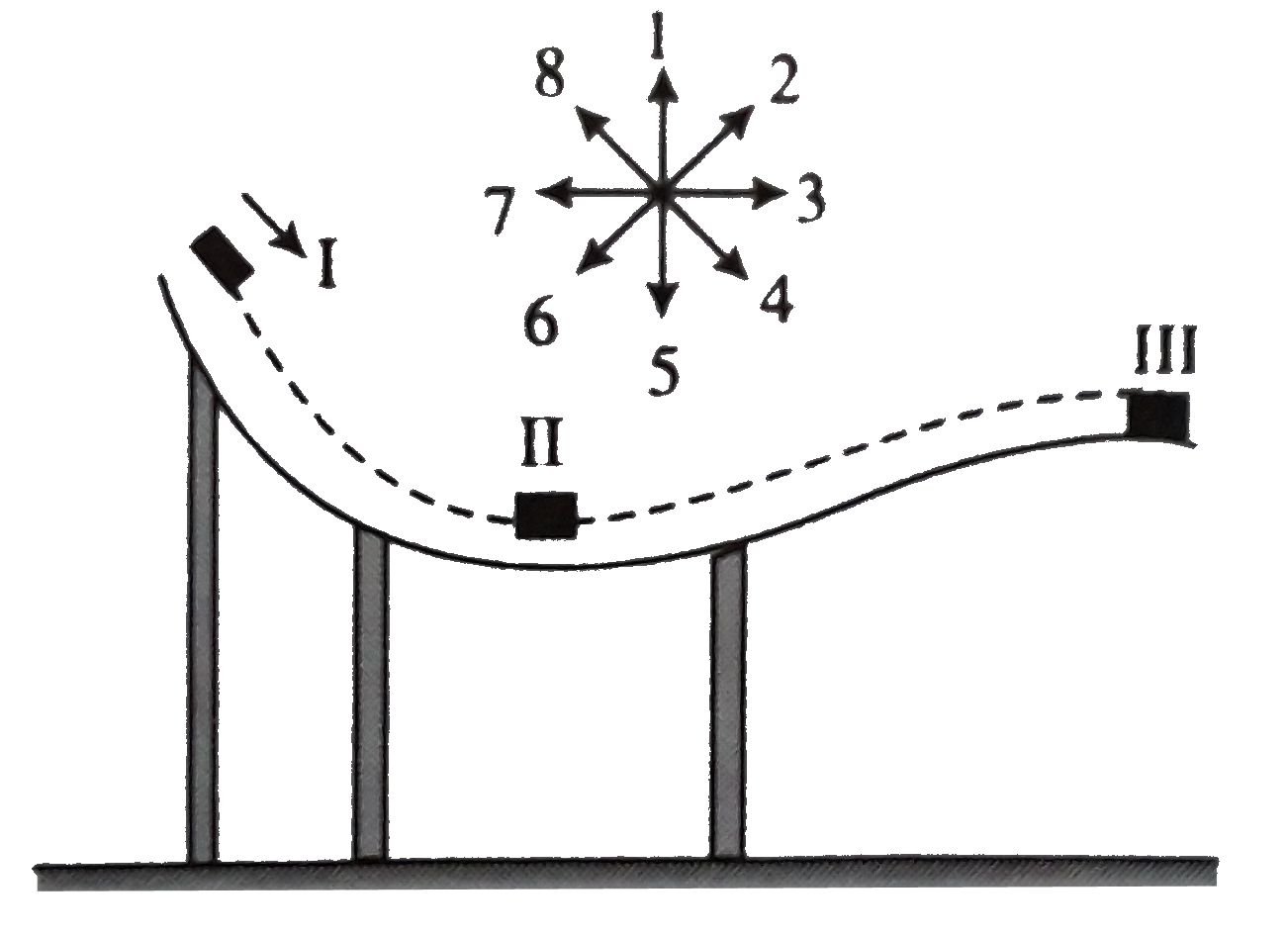
Position - i : Starts sliding on curve path
Position - ii : Lowest position of the curve path
Position - iii : Just outside of the curve path
The direction of the acceleration of the blocks when in position i is best represented by which of the arrows in the diagram
View Solutionfigure depicts a block sliding along a frictionless ramp in vertical plane Eight numbered arrows in the diagram repreesent direction to be referred to when answering the questions
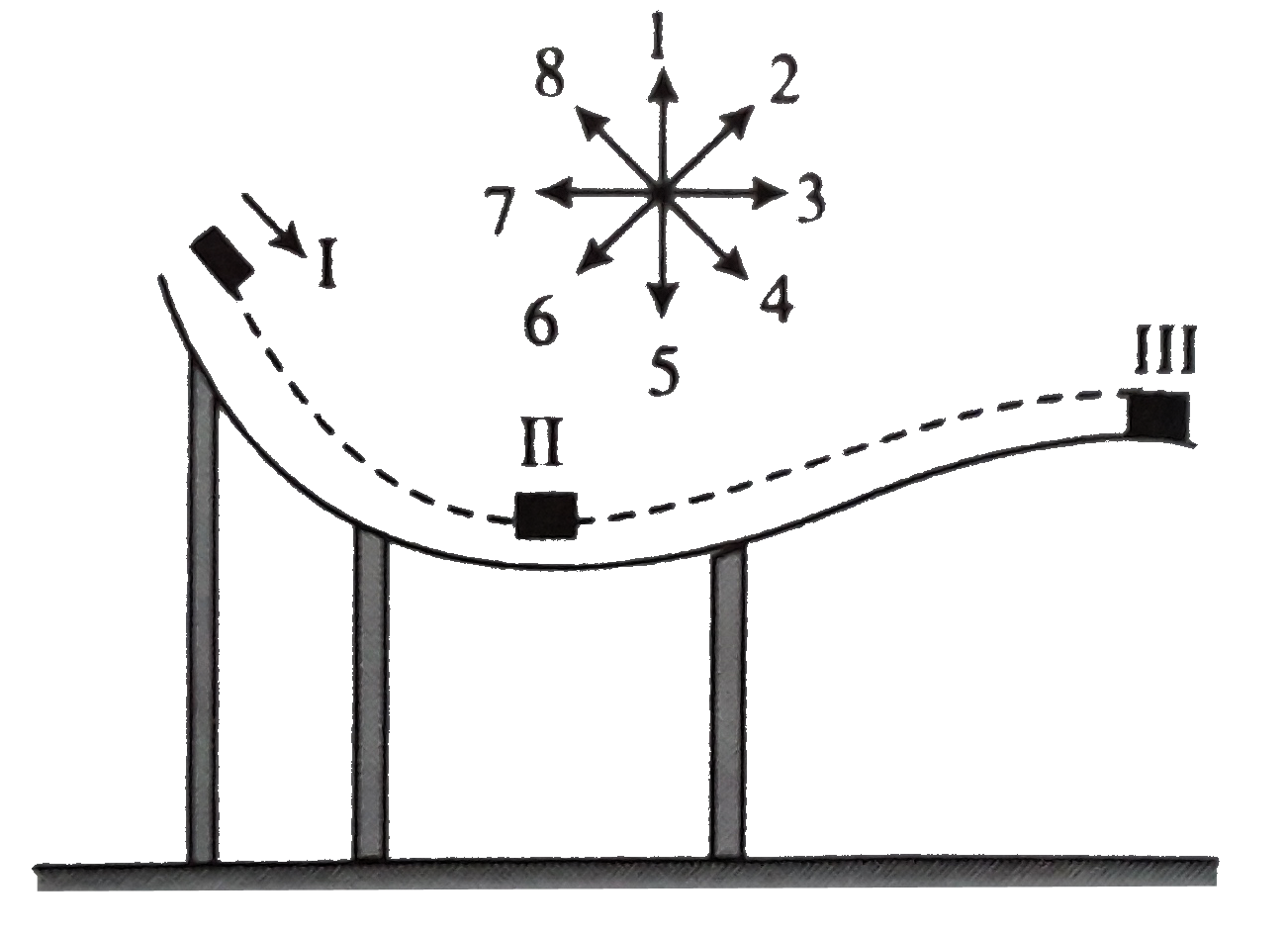
Position - i : Starts sliding on curve path
Position - ii : Lowest position of the curve path
Position - iii : Just outside of the curve path
The direction of the acceleration of the blocks when in position ii is best represented by which of the arrows in the diagram?
View Solutionfigure depicts a block sliding along a frictionless ramp in vertical plane Eight numbered arrows in the diagram repreesent direction to be referred to when answering the questions
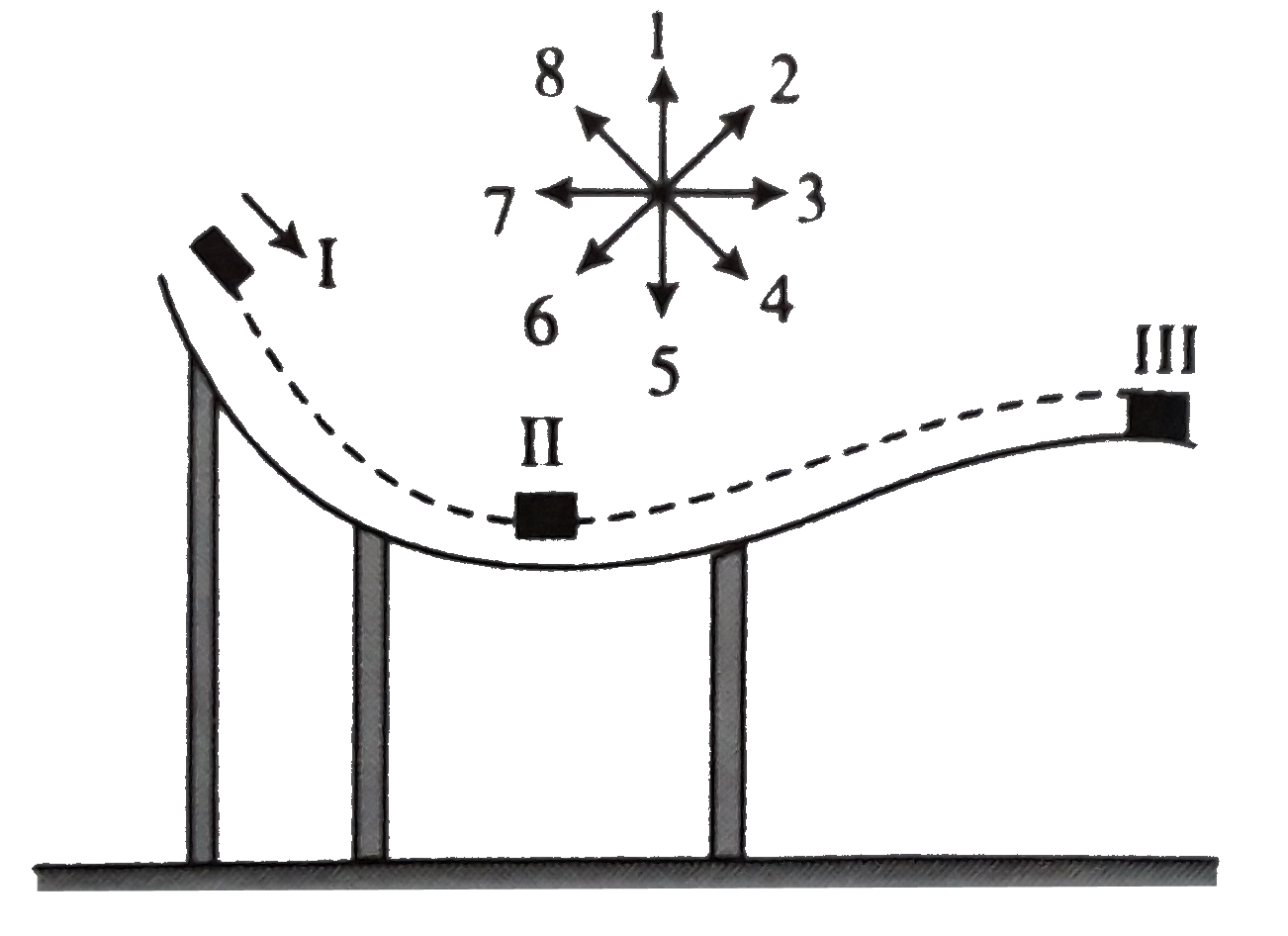
Position - i : Starts sliding on curve path
Position - ii : Lowest position of the curve path
Position - iii : Just outside of the curve path
The direction of the acceleration of the blocks (after leaving the ramp) at position i is best represented by which of the arrows in the diagram?
View SolutionThe coin is notating with a plate without sliding If the coefficient of friction between the coin and plane is `mu = 0.75` the friction between the coin and plate is
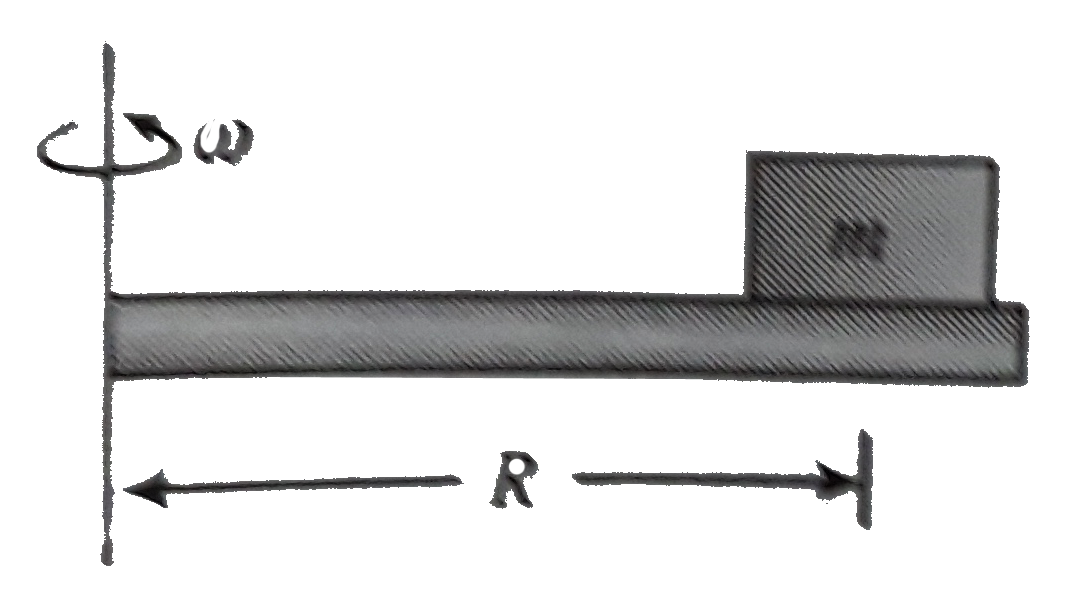
If the angular frequency of the rotation of the plate is `omega = sqrt((g)/(2R))` the friction force acting on coin is
View SolutionThe coin is notating with a plate without sliding If the coefficient of friction between the coin and plane is `mu = 0.75` the friction between the coin and plate is

If the plate is rotating along and the coin is gently placed on the rotating plate, the frictional force on the coin is
View Solution
Linked Comprehension questions and complete solutions for chapter NEWTON'S LAWS OF MOTION 2 of CENGAGE PHYSICS (HINGLISH) of Class 11